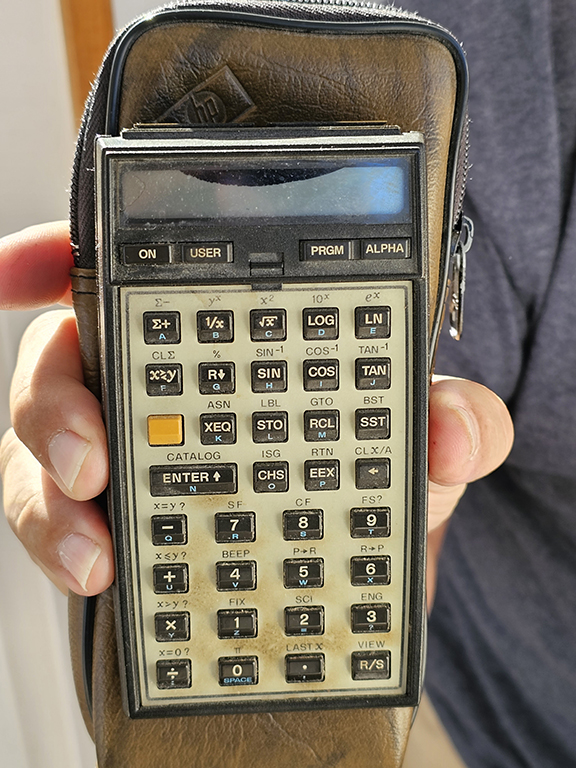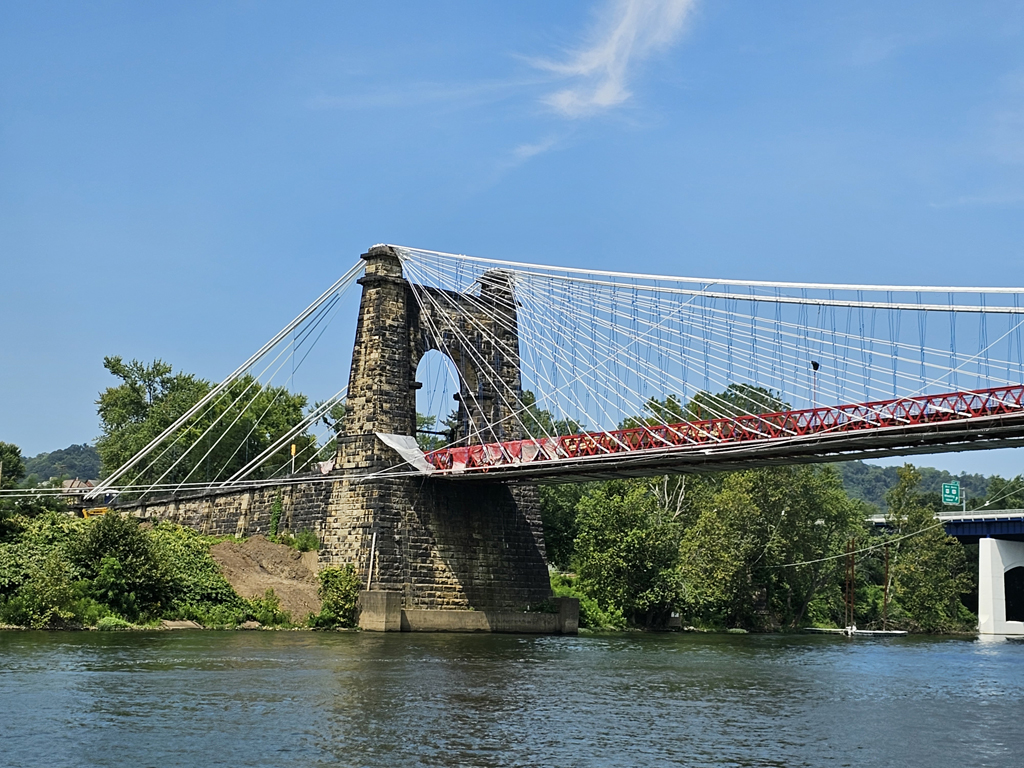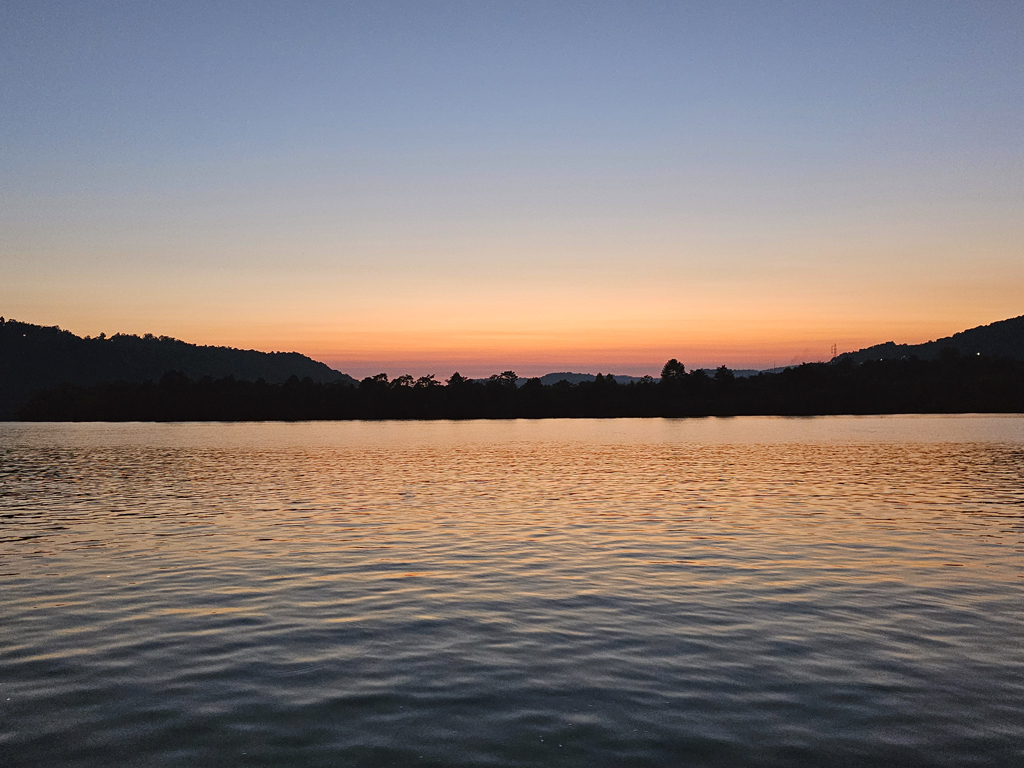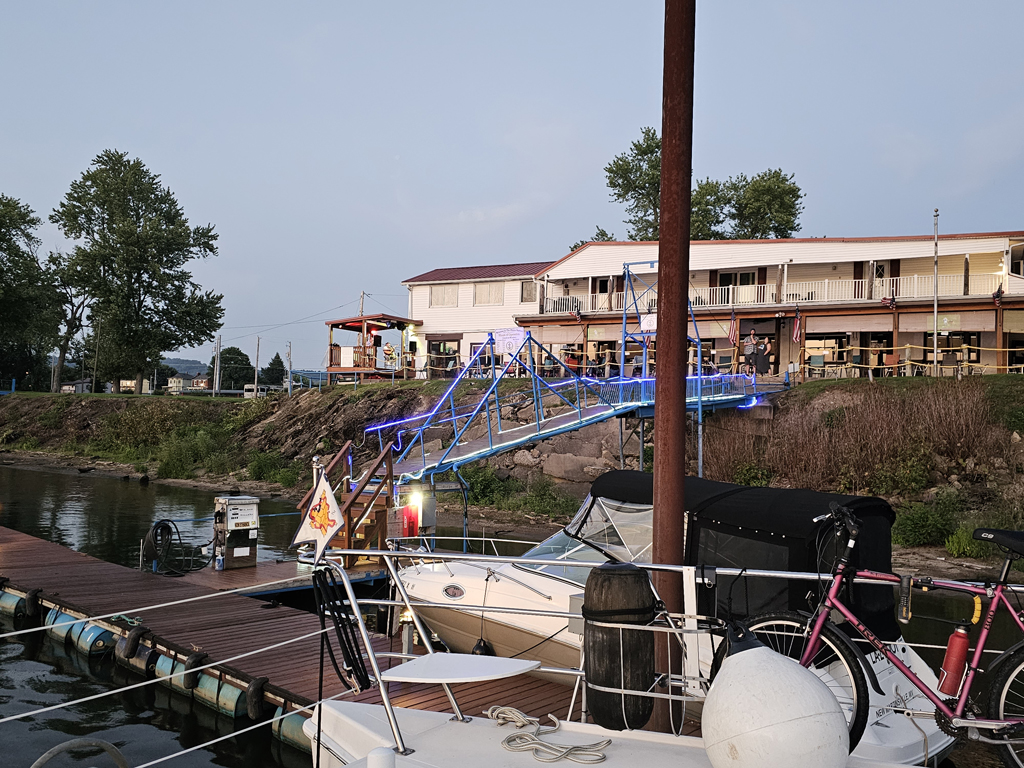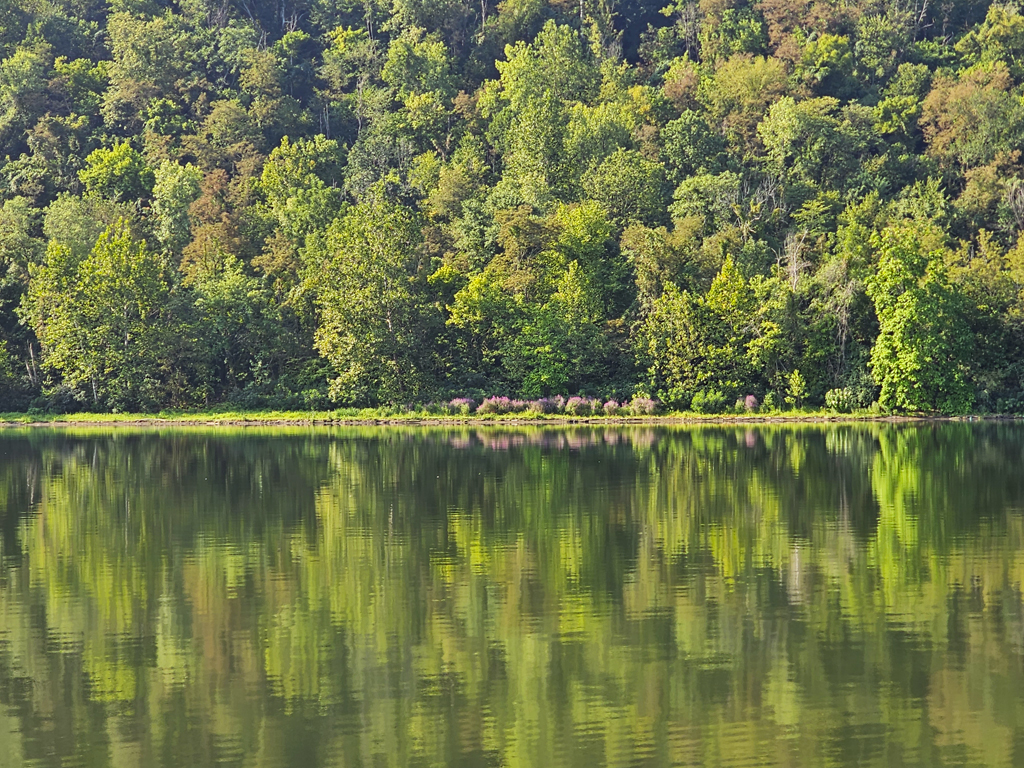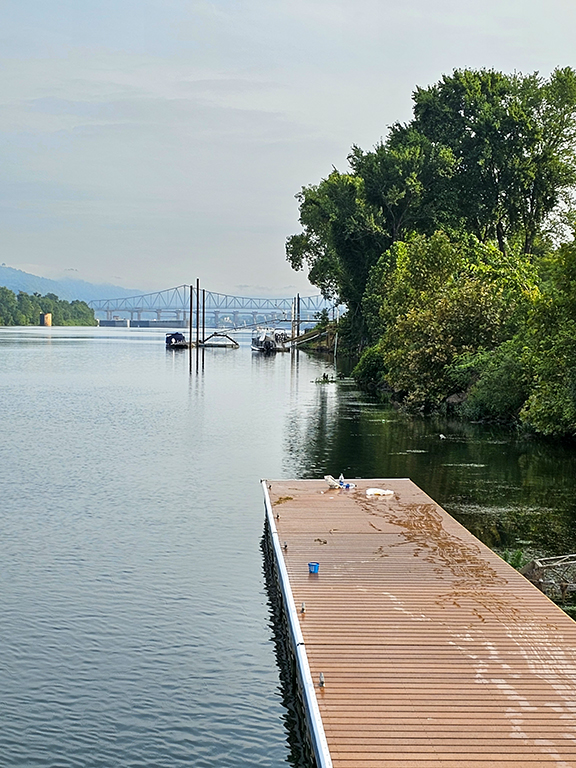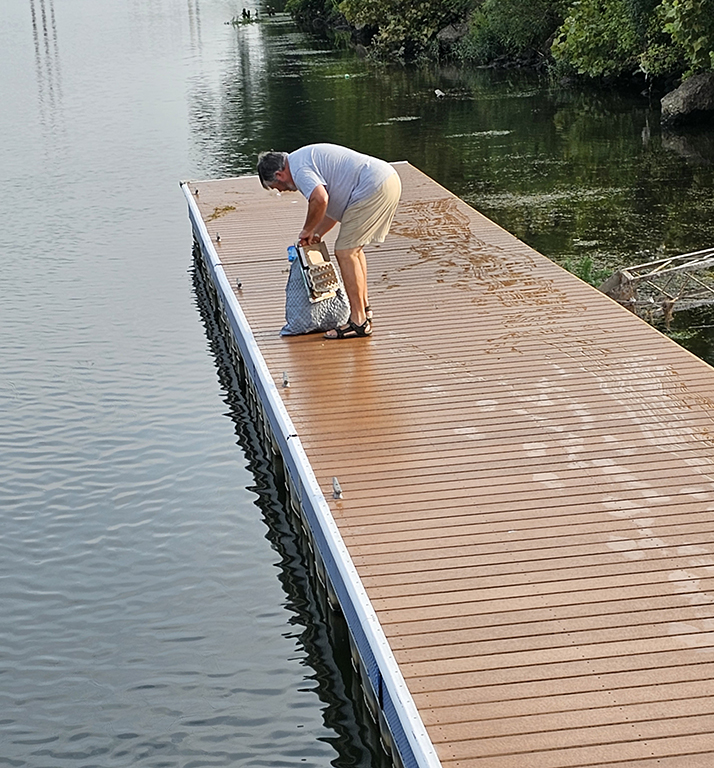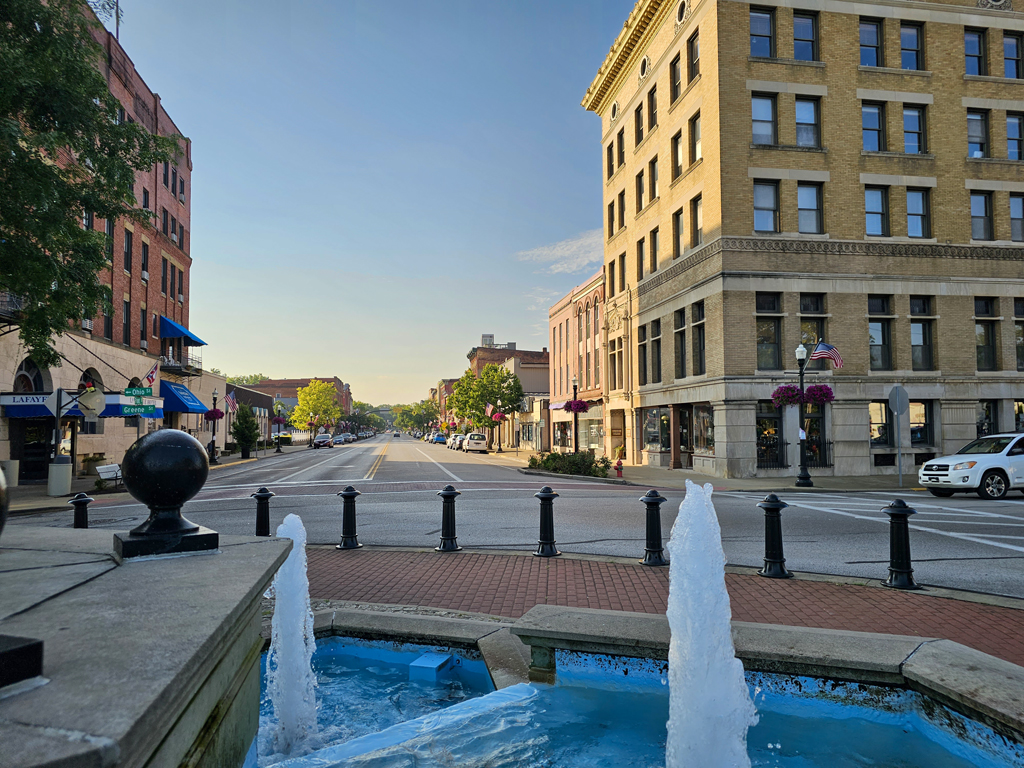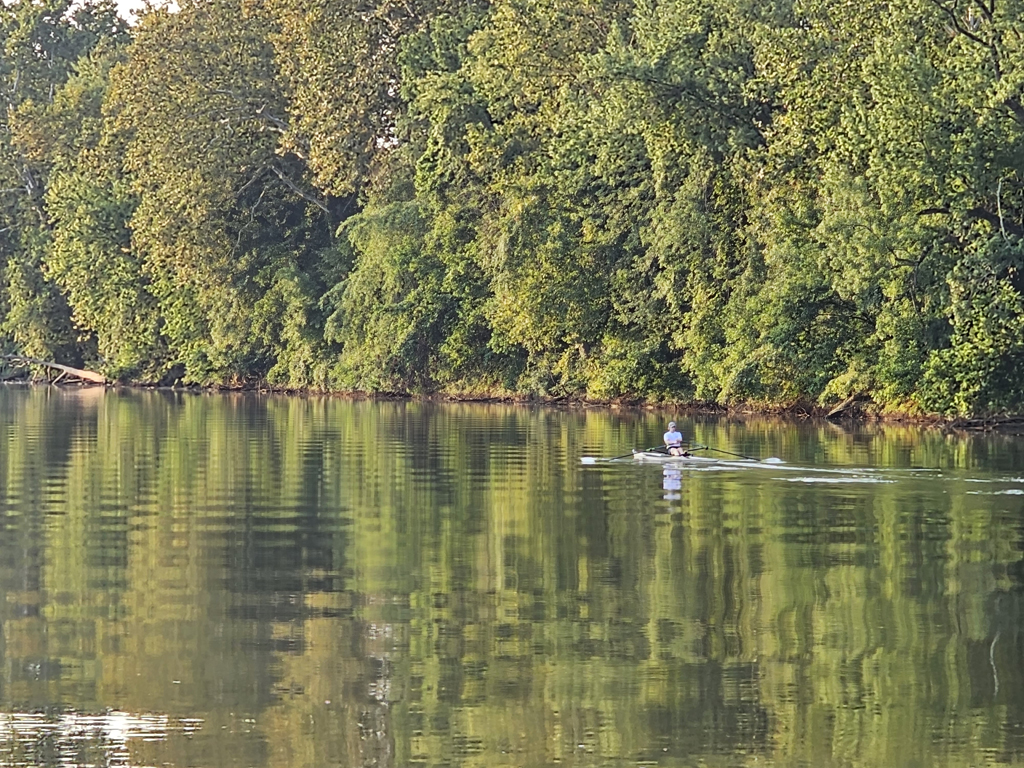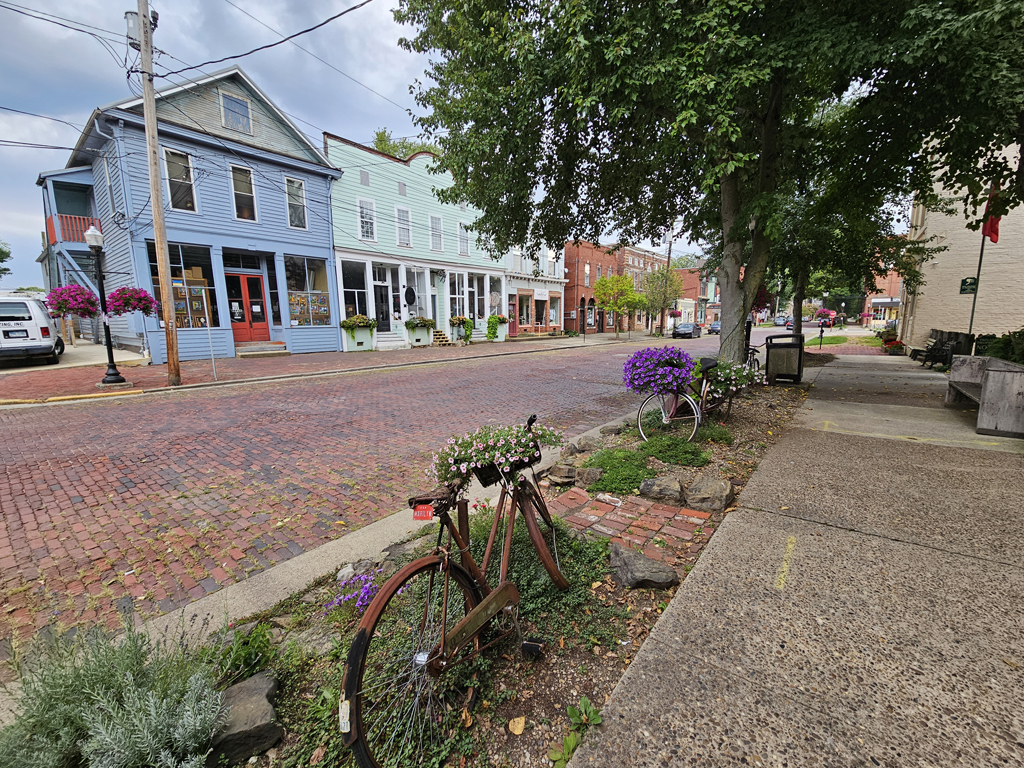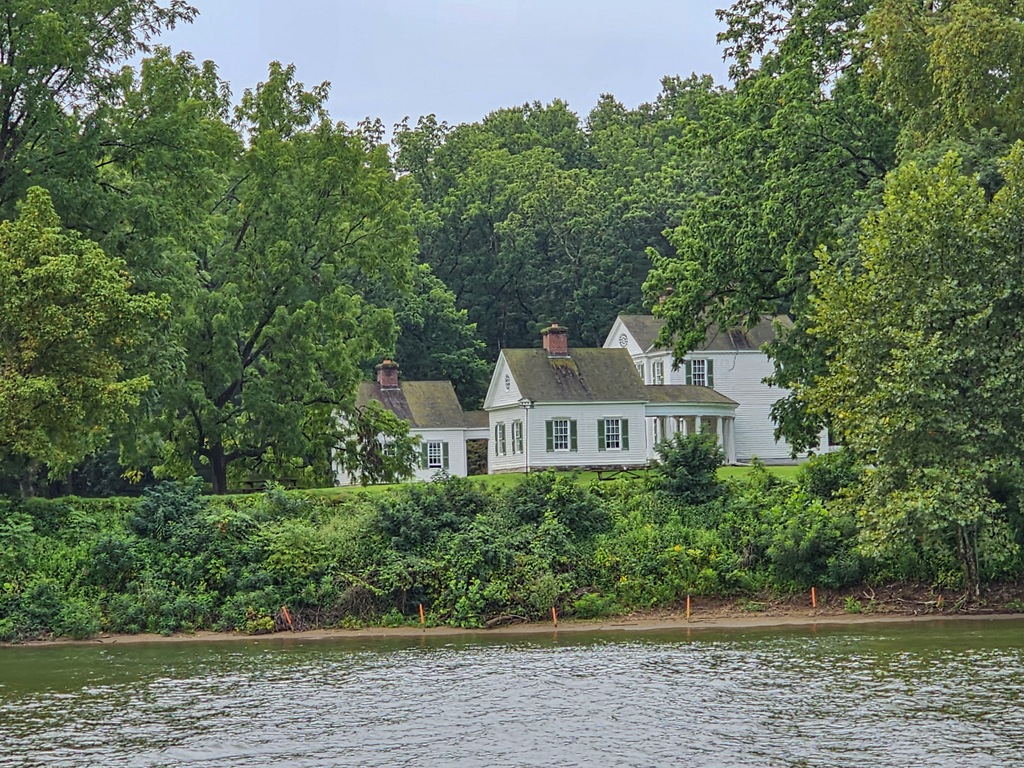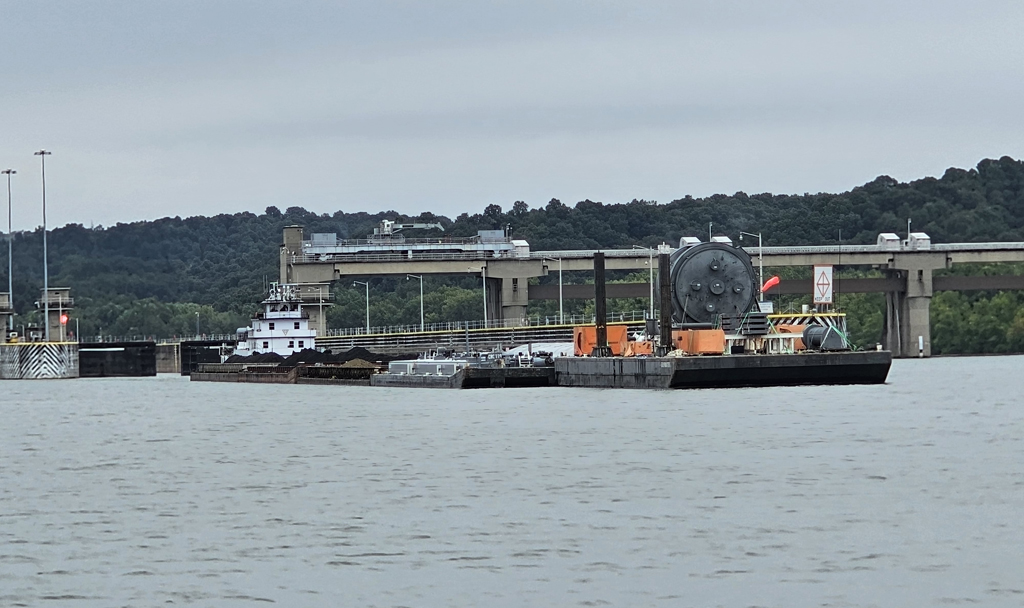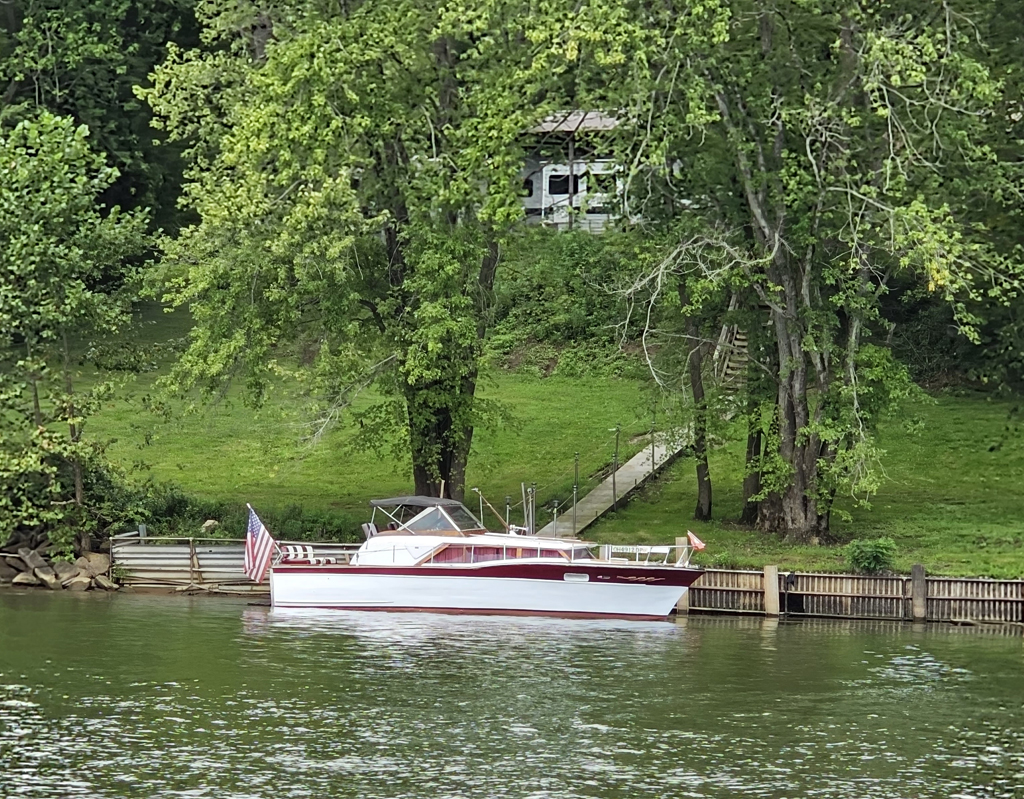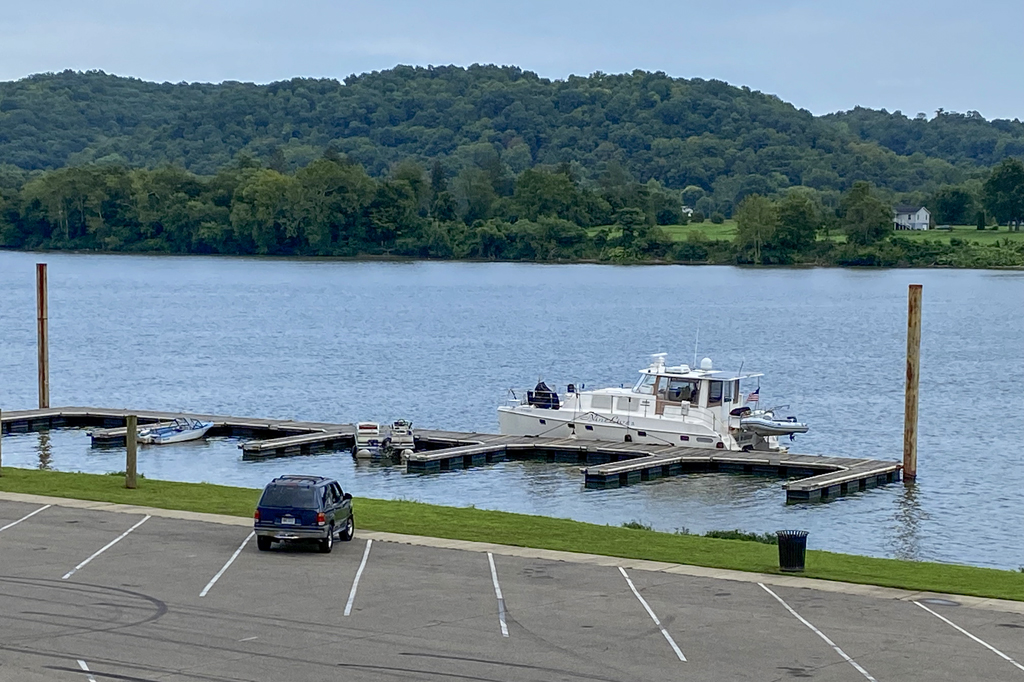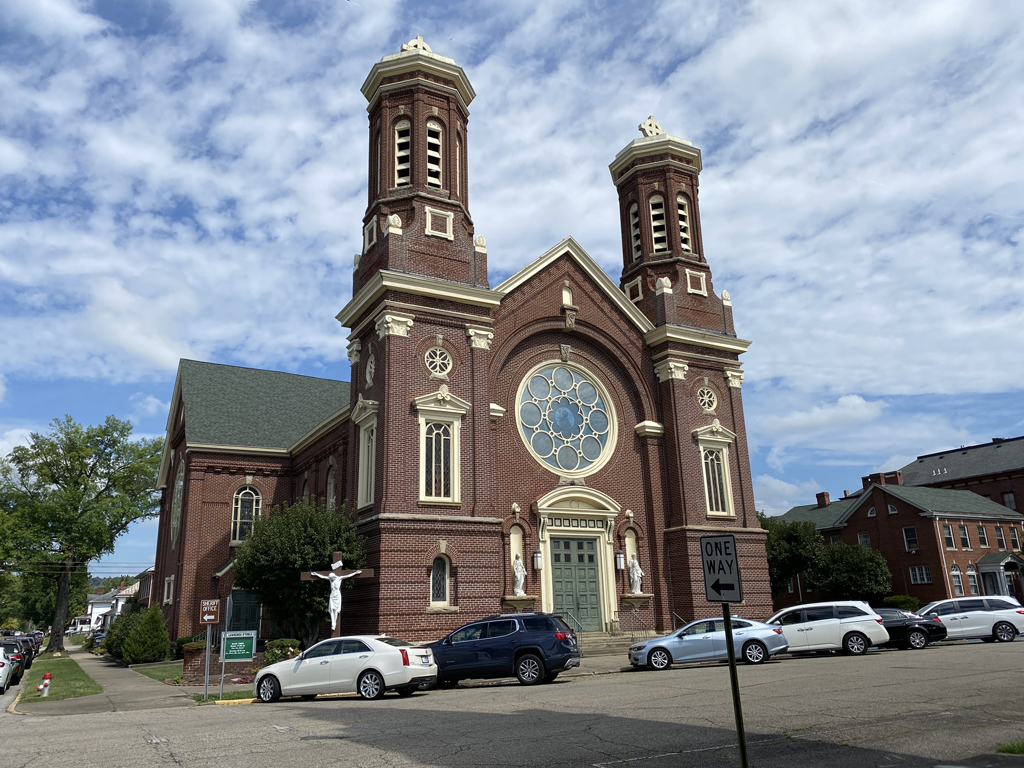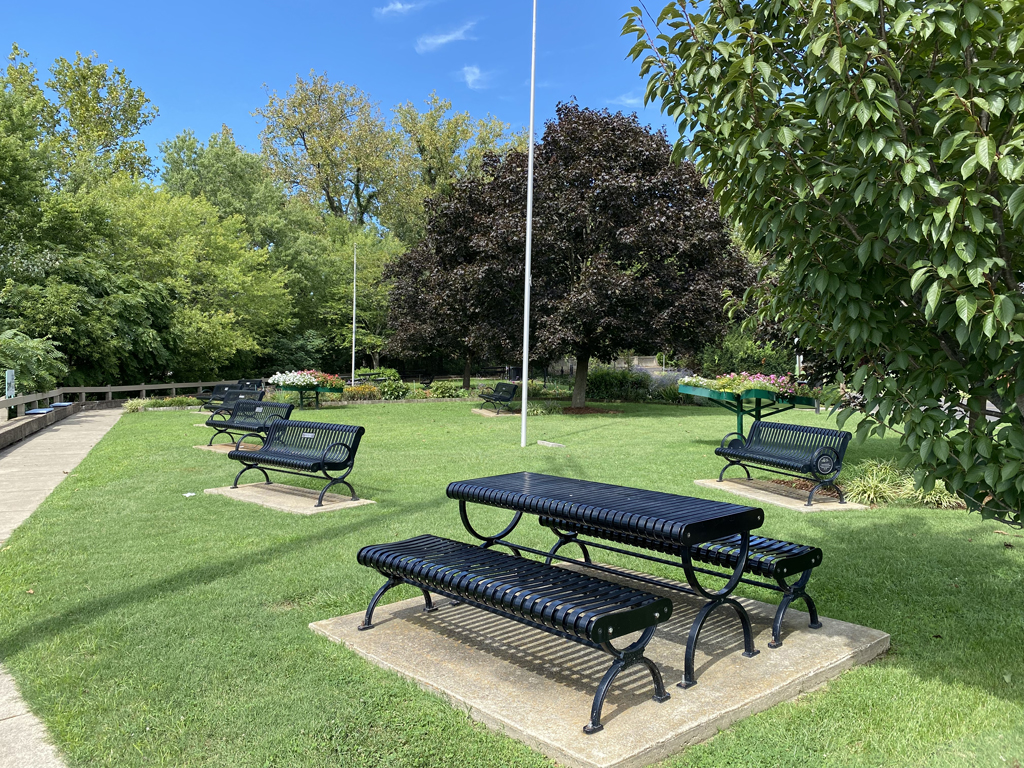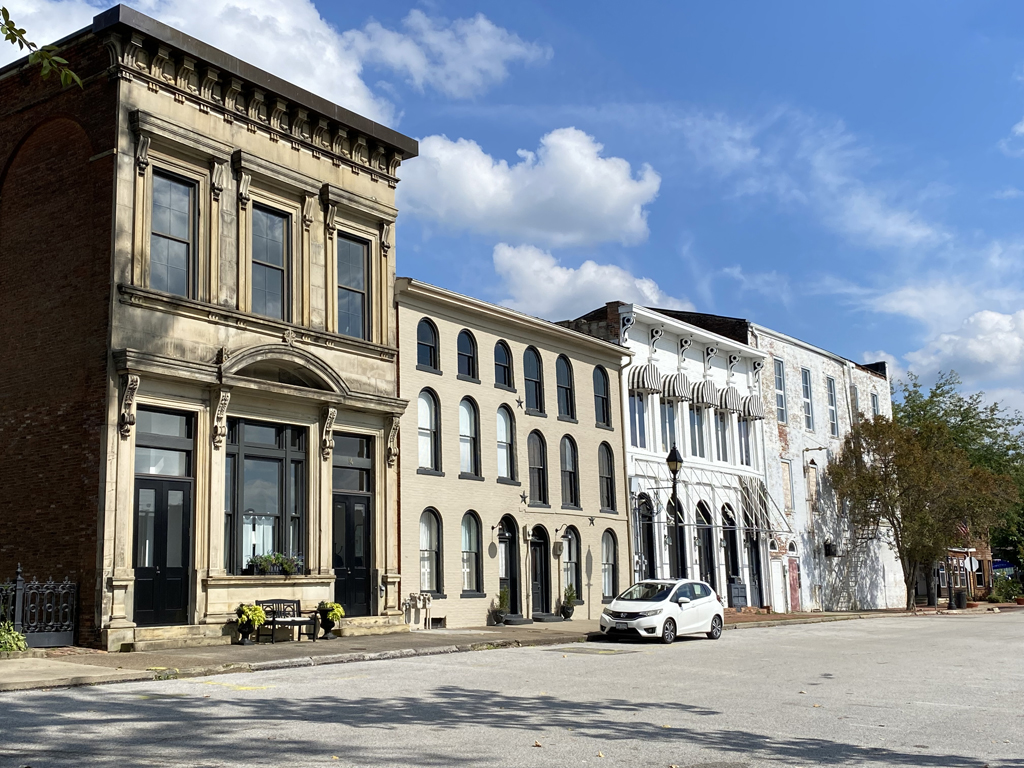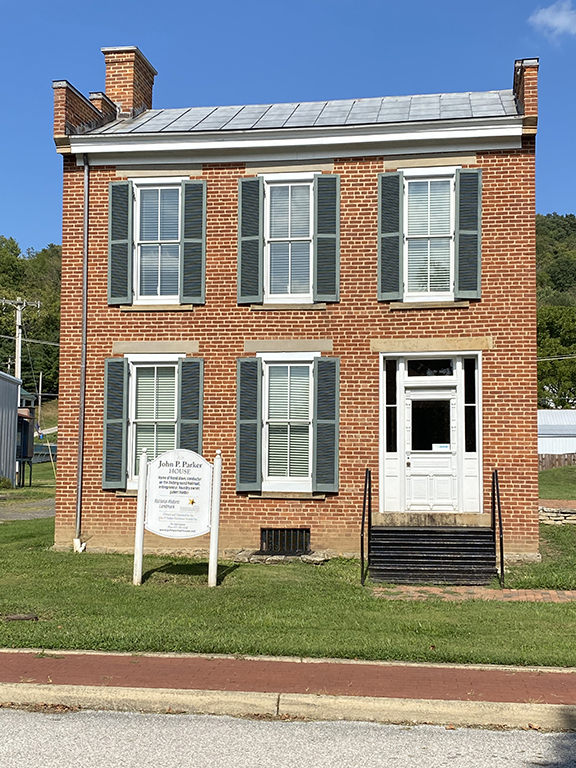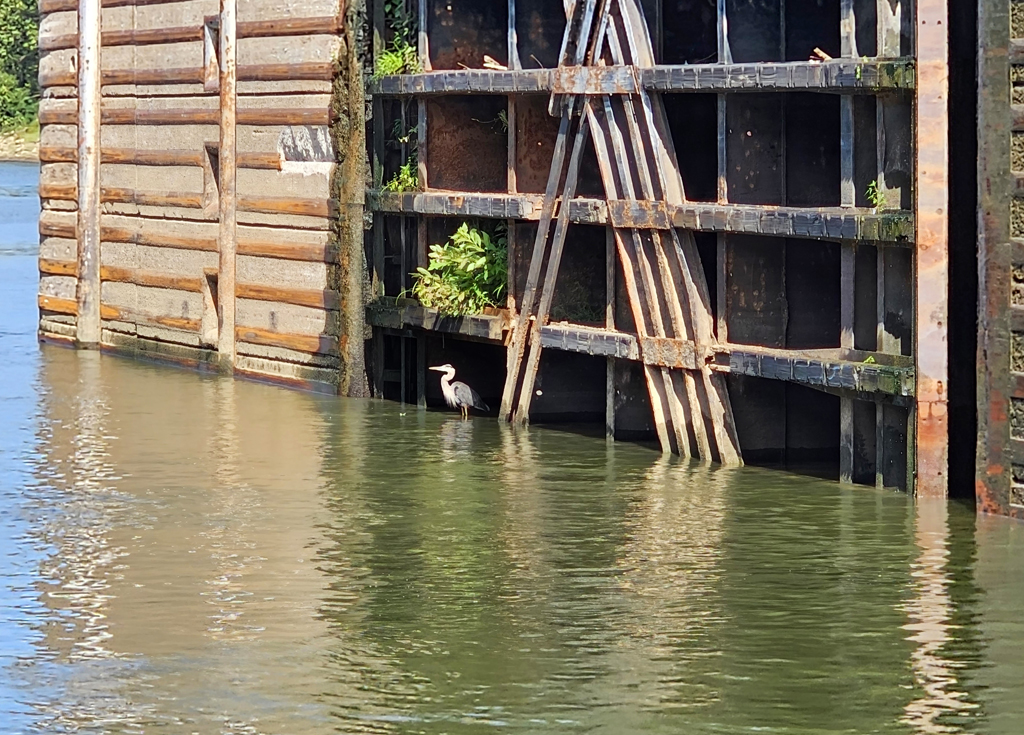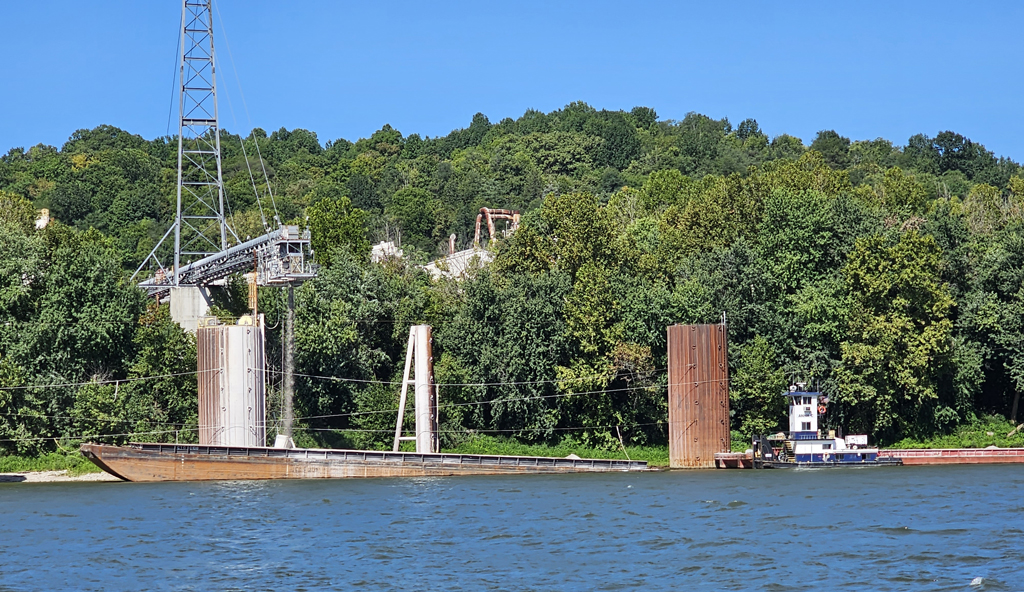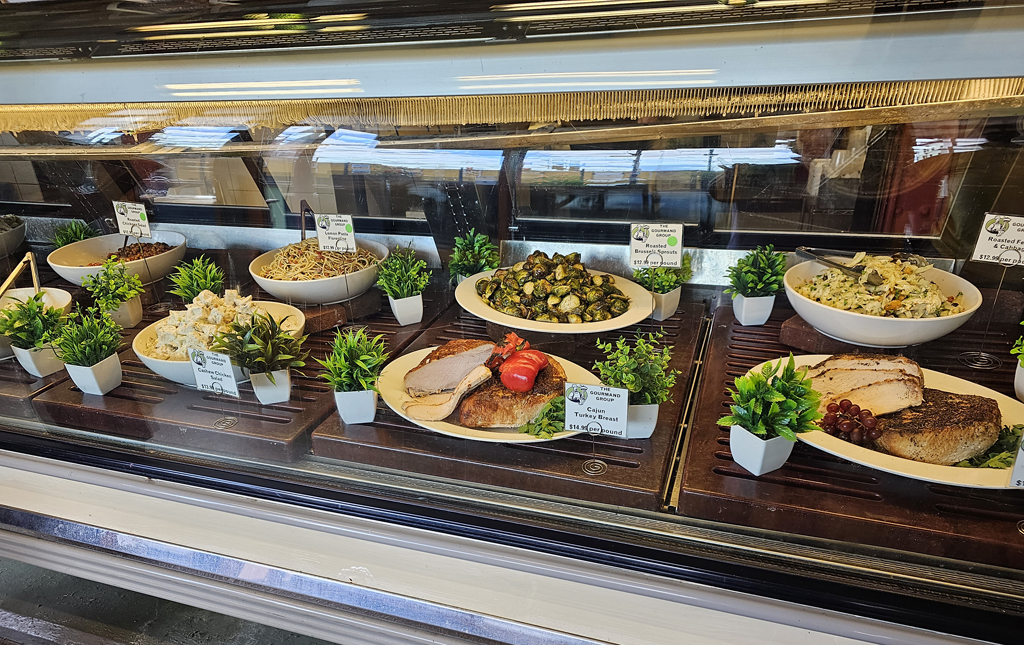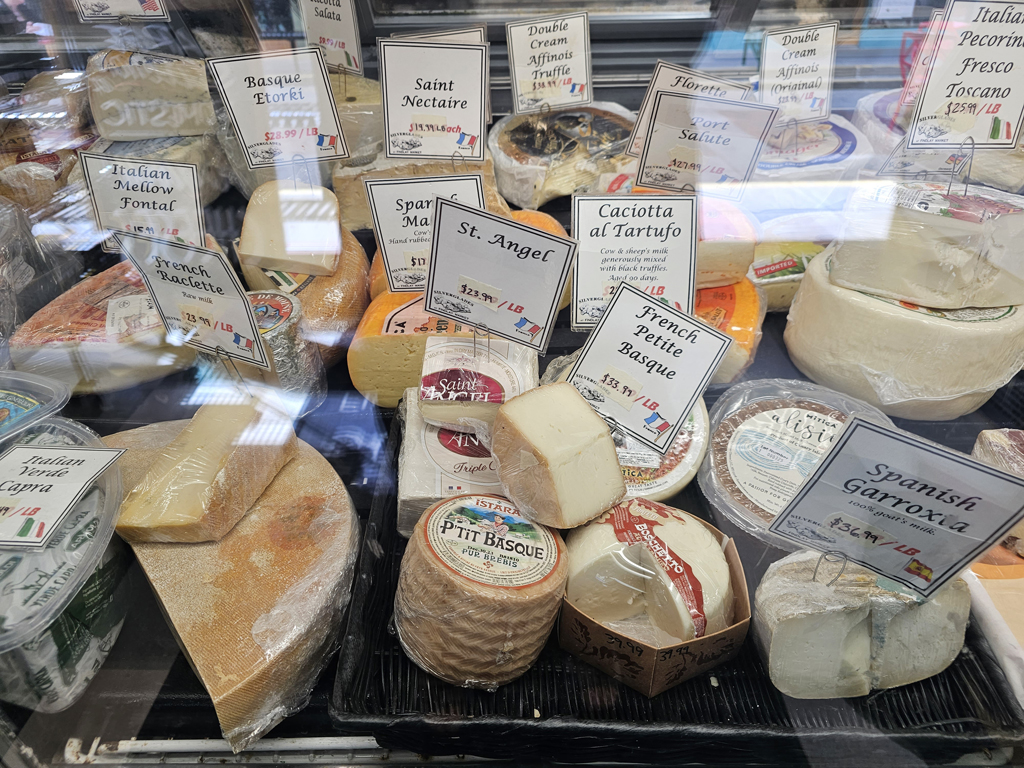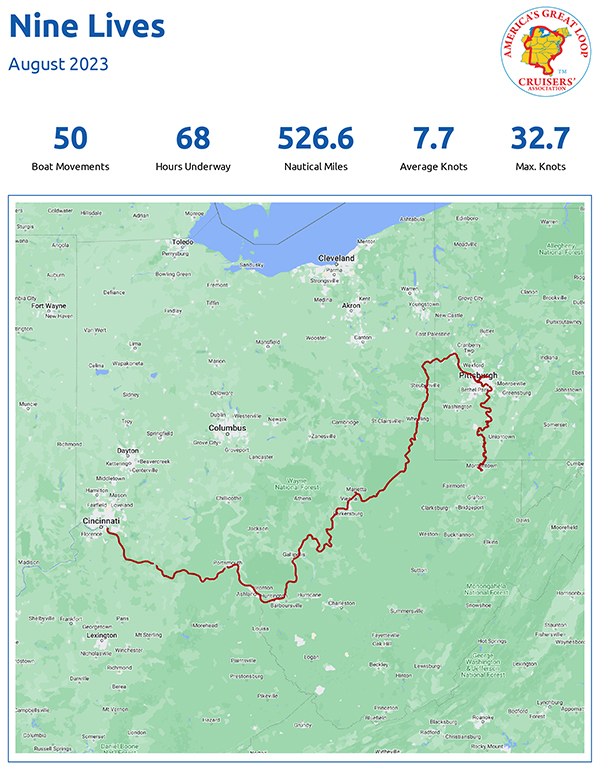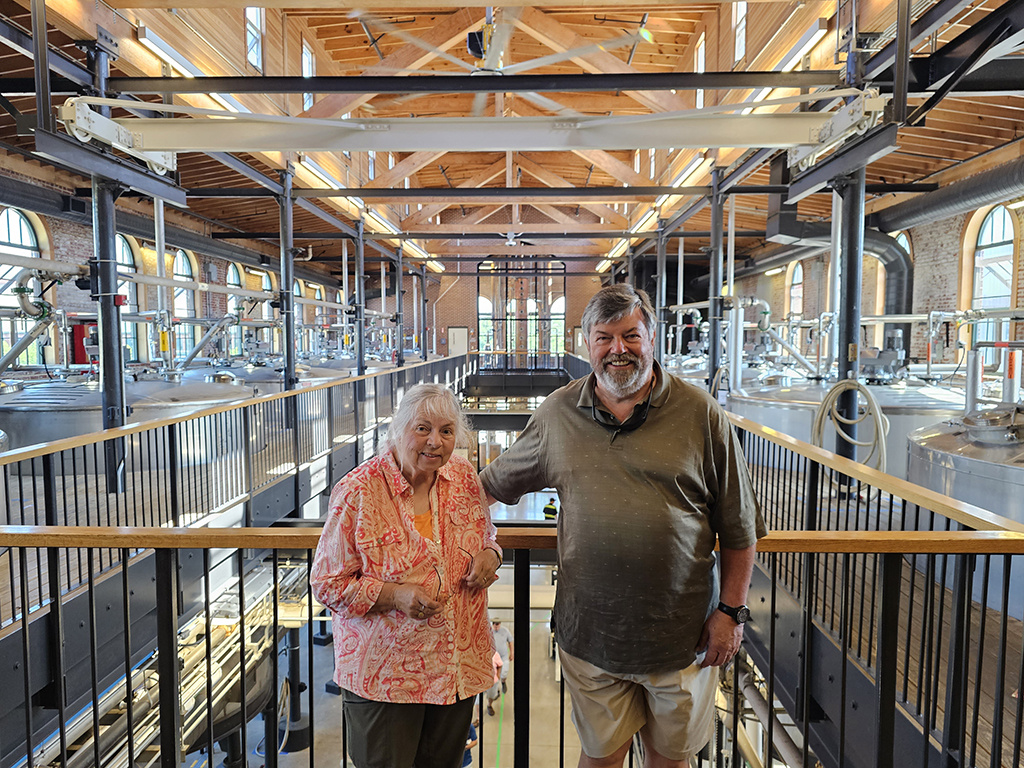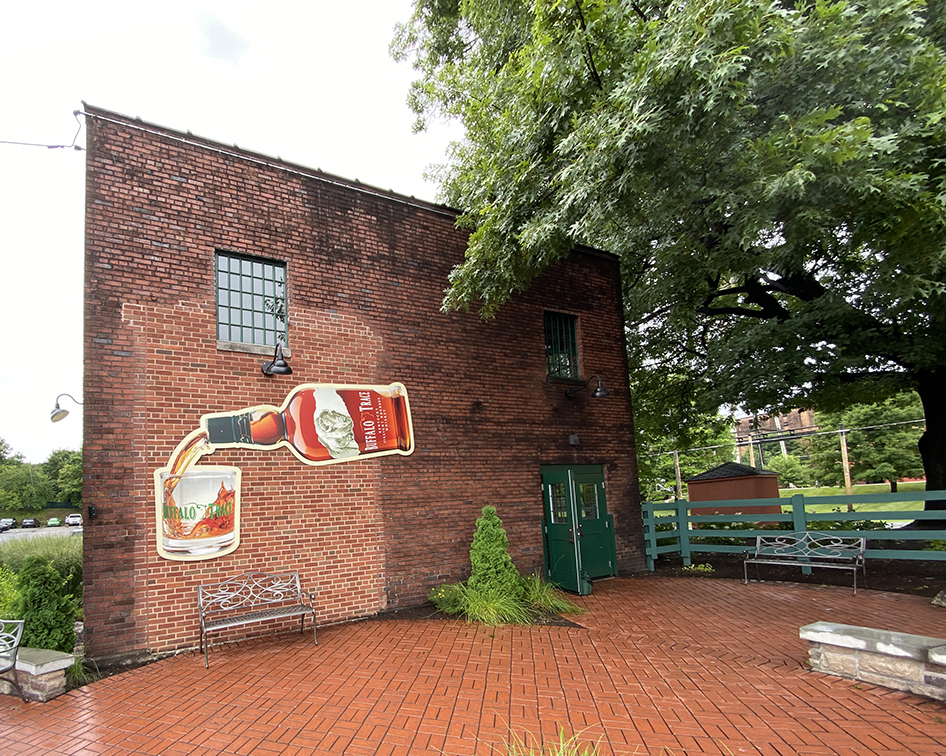September began with a fascinating driving tour of Cincinnati with Audrey. She was a great guide. After a brief stop at the Lunken Field Airport to see the historic planes that were in town for the long weekend, we drove across the river to Newport. Once a lawless and dangerous place, it became a city of gracious homes with beautiful gardens. Back across the river, and a highlight was the Spring Grove Cemetery. It is a beautiful place with many imposing monuments reflected in peaceful lakes.
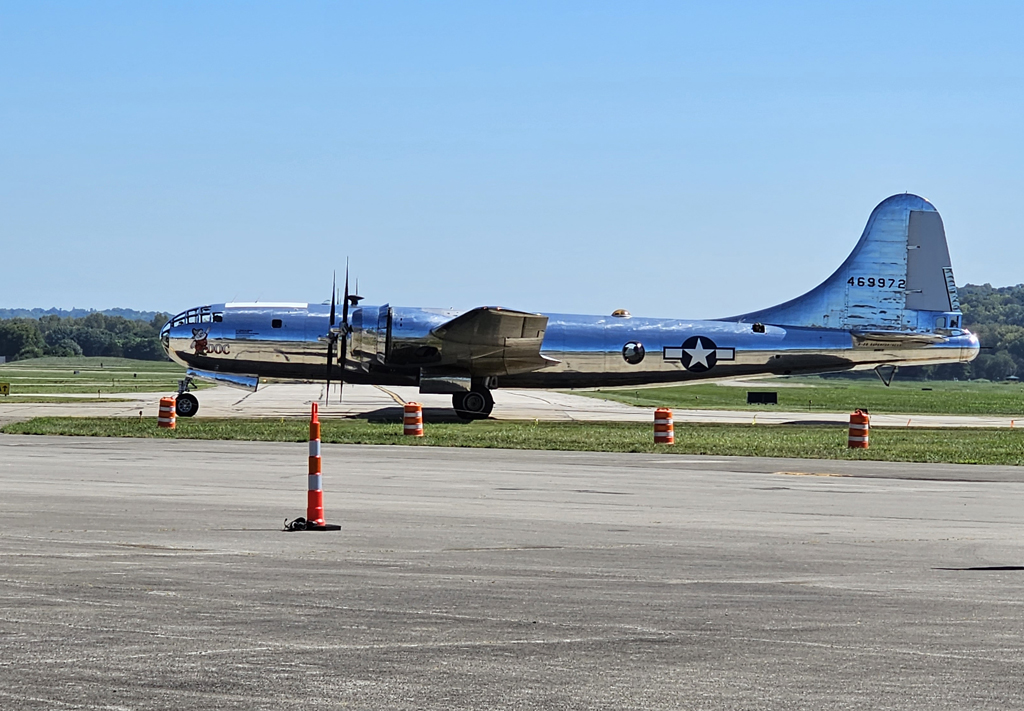





Our dinner at Boca was one of the best this trip. It was a strange menu, with “small bites”, that are not sharing size, followed by “petits plats”, which include small individual or sharing portions. The idea is that you order two or three in each category. We began with two of the tiny plates, a lobster roll, and pommes souffles, puffed potatoes with dipping sauce. I tried a sort of corn dish with pasta and jalapenos, and Dick ordered a salad. We shared a delicious pasta Bolognese dish, and then we ordered the beef wellington. That was definitely sized for sharing, and was delicious. We were also delighted that it was plated in the kitchen, so much more civilized than expecting us to divide it into messy portions ourselves. Desserts were a highlight. Dick ordered panna cotta, and my dessert was “Le Citron”, a lemon dish that I will remember for a long time. It arrived on the plate, looking just like a real lemon, set on a lemon shortbread in Italian meringue. I was a bit disconcerted to be presented with a steak knife, but it became clear when I used it to cut the “lemon”. It was a hollow form made with white chocolate. Inside was lemon curd, and preserved meyer lemon. There was also some sort of cheesecake filling. It will be a long time before I have a dessert that is as creative and delicious as that one.






We were invited for the coffee and donut gathering at the Yacht Club the next morning. Audrey joined us. Later we visited Darlene and Mike’s boat, Riversong, and then they walked over to see Nine Lives. They will begin their loop later this month, and we hope to see them further down the rivers, or perhaps in Hilton Head. We were quiet for the rest of the day. Dick made a run to the liquor store to replenish our stocks, and I finished the blog for the previous two weeks.

We had a nice, and very authentic dinner at The French Crust. It started poorly though. Dick tried two different parking places, and the charge to park was a flat rate $25 to park until 4am. Since we only wanted 2 hours, he was very annoyed. As my Mum used to put it, “I want to park, not buy the lot!” (she was objecting to a $3 charge!) Once Dick decided to accept the inevitable (with much grumbling), we arrived at the restaurant to discover that it is so authentic that there is no air conditioning. It was 93F that day. Apparently, they do have AC, but it has been broken for 2 months! Our waiter had been there since 9am – we felt very sorry for him.
Dick’s escargot were good, but as in other places, not garlicky enough. My pork pate was very tasty. We both ordered the vol au vent with shrimp, scallops, and vegetables in a white wine cream sauce for our main course. Dessert was pot de crème (a dense chocolate mousse), delicious, but double the size it is supposed to be.

Later, I looked up the parking information, and sure enough, all city parking is $20 to $30 on a “special” weekend. Note to self, avoid “special” weekends in cities, not that we had a choice on this occasion.
After our return to the marina, we met a couple we had chatted with on the radio on the Ohio River as we passed each other a few days earlier. They came on board for an evening drink and chat. It was most enjoyable, and went well past Looper midnight (that is generally accepted to be 9pm)!
September 3rd. We had booked a Segway tour for the morning. It was supposed to be in the downtown riverfront, but that was not allowed due to the big fireworks weekend. Instead, we toured Eden Park. It was a good tour, with nice views of the river with boaters gathering for the fireworks. For a change the other people in the group arrived early as requested, so we didn’t lose time while they learned how to ride the Segways. They also were good, careful riders, another nice change from our last experience! After the tour, we went to Jungle Jim’s, a huge international supermarket. We found a few things to add to our pantry.


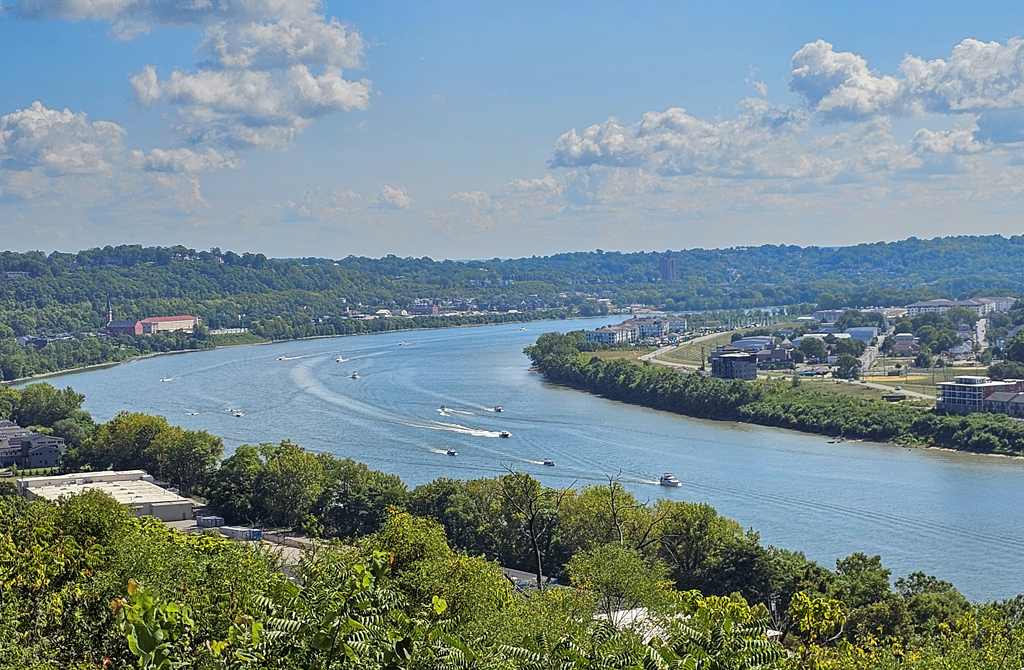
We had the boat exterior cleaned by a local boat cleaner. She didn’t do a particularly good job, merely adequate, but it did get rid of the hideous Ohio River moustache that was marring Nine Lives’ once pristine hull.
Dinner at Nicholsons was a disappointment, mainly for Dick, as I had no great expectations. I knew that the so-called Scottish Pub had few choices for me. They were busy, and clearly short of wait staff, as we were looked after in a sporadic manner by a lady who was a supervisor, not a waitress. We were left sitting with no drinks or orders taken for 15 minutes after we arrived, and it never got any better. The food when it was delivered was cold. Dick’s Scotch egg was the only highlight.


Fortunately, we had found a parking garage with “Event pricing” for $15, so not quite as bad as the $25 or $30 we would have paid on the street or in a city lot. At least Dick didn’t have that extra stressor to spoil his evening! As we drove back over the Ohio to return to the marina, we could see all the boats anchored for the fireworks. Many were rafted up 4 or 5 boats. Sadly, there was no way to take a picture, as it was an amazing sight, seeing the river completely filled with small craft. All tow traffic is stopped for the fireworks event.
We could not see the fireworks from the marina, and had no intention of either driving to a viewing spot, or worse, taking the boat and anchoring with people who go out once a year and had been drinking all day! Locals were mystified to hear that we would not see the fireworks, it would seem to be mandatory for everyone who lives in Cincinnati.
On our last evening we had an excellent dinner at Eddie Merlot’s, a small chain of steak houses. The food was delicious, and the setting was a gorgeous modern restaurant with stunning décor, artworks, and stained glass. Back at the marina, we were joined on board for a nightcap by Jon, another Looper who we had met in Pittsburgh. Jon is single-handing, occasionally joined by friends and relatives. We enjoyed exchanging stories of our adventures.





We liked Cincinnati. It is a very clean city, and there is clearly a lot of wealth and prosperity. We saw a lot of the city while we drove to restaurants and shops, and there was very little evidence of the usual big city poor neighbourhoods and homeless people.



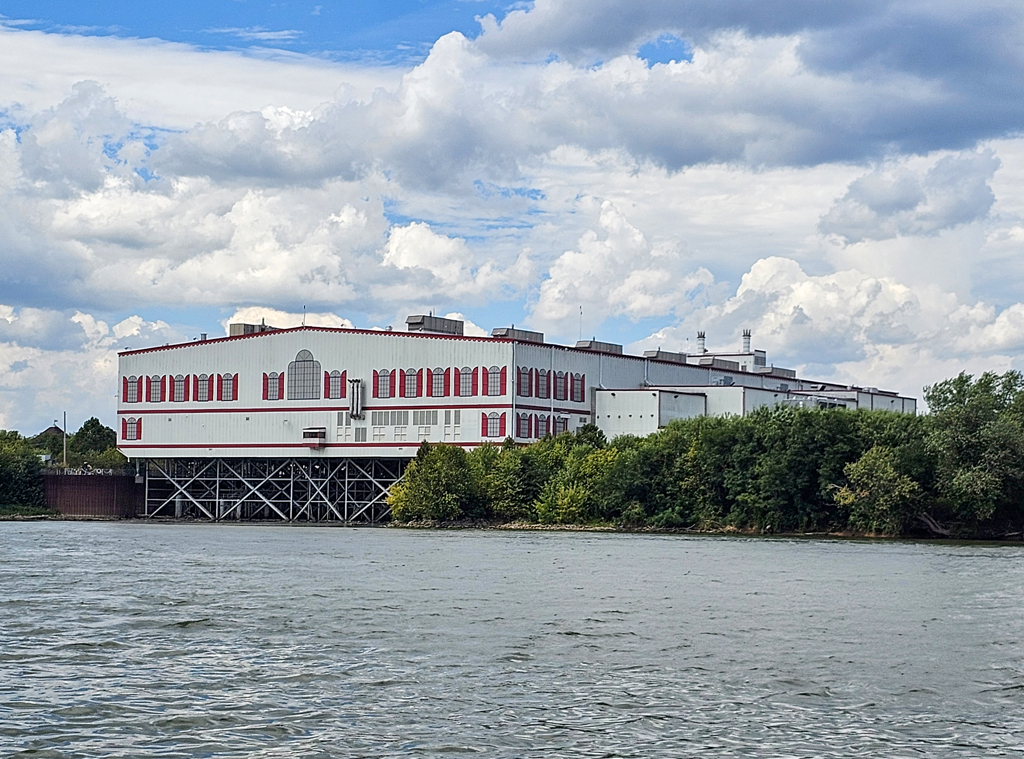
Leaving Cincinnati, we arrived at Rising Sun at 2:30. It was an incredibly hot day, the weather report said “feels like 99”. It did. The city has an excellent dock for visitors. Dick was struck by how clean and tidy the town is, real civic pride. Rising Sun has a seaplane repair shop. We were surprised to see this, as we have seen no evidence whatsoever of seaplanes anywhere on the Ohio.

Rising Sun, although small, was a center of invention. J.W. Whitlock invented an automatic harp, that is considered to be a precursor to the jukebox. He also invented a coin operated horse racing game. His biggest achievement was a racing boat, that set the speed record for travelling the 267 miles from Cincinnati to Louisville and back, at just over a mile a minute in 1924. This record still stands. The attempt was made on a day that the river was full of debris. When Whitlock arrived back at Cincinnati, there were cheering crowds waiting to congratulate him, but he just waved and then turned around and returned to Rising Sun. His boat, The Hoosier Boy, had been holed by debris during the race, and if he had stopped to accept the congratulations from the crowd he would have sunk. The record will never be matched, because the Markland Lock and Dam has since been built between the two cities. Another Rising Sun resident, Henry Clore, was a blacksmith who set up a shop to produce ploughs. By 1880, his company was shipping 6000 ploughs a year down the Ohio to southern markets.


A horse ferry operated across the Ohio to Rabbit Hash (famous today for its succession of canine mayors). There were two ferries. They were propelled by a team of horses on a treadmill. Apparently, blind horses were preferred, because they had no fear and were thus easier to manage. A ferry still plies the waters between the two towns, but the horses have been replaced by diesel engines.
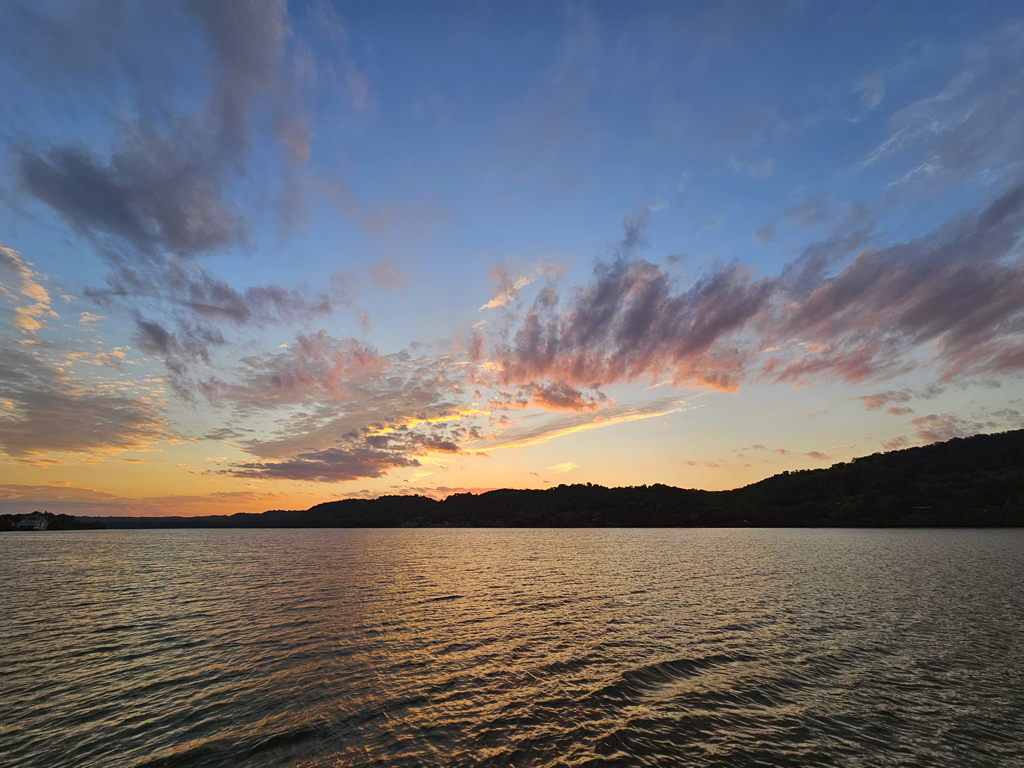
September 16. We were out by 8:30, with a fairly long day and one lock to transit. There was a little bit of waiting at the lock while a large tow pushed into the other chamber. We had planned to stop at Madison town dock, but although it is a good dock, they are strict about no overnight stays. Another Looper boat was planning on stopping at the marina, so we decided to try that, not wishing to pay the exorbitant $3/ft that we paid last time at the riverfront restaurant and dock. The marina is better, at $1.75/ft, but even that is more than what is usual on the Ohio. The challenge was that it is very shallow, and there was a dredge parked in a very inconvenient spot in front of our assigned slip. Dick managed it, with 2 feet under the boat, and then we discovered that the expected 20-foot-wide slip isn’t. Nine Lives could go no further forward, she was tight against the side posts, and that was before her widest part! Dick called the dockmaster, who was making his way over to help us tie up, and his comment was “I see your problem”. Fortunately, there was another, wider slip, that we could get into (although with zero depth showing below the boat). We were at the opening end of the 80 ft slip, and we thought that the power pedestal would be too far away, but the helpful dockmaster promised a solution. Sure enough, a few minutes later, he produced a long cord to attach to ours. We could only use half the available power (we would have needed a second long cord, which was offered), but we were able, with careful power management, to use both air conditioners, so all was well. Dick has an extra hose on board, so reaching the water tap was not an issue.
We met the gold Loopers, who we had been watching on Nebo and also had corresponded with online about the J.T.Meyers lock closure. They joined us on board for docktails, and then we all walked to town and enjoyed some truly excellent pizza. Chance meetings like this really make the whole Looping experience special!
We were wondering how challenging our departure was going to be. Dick had a word with the dockmaster in the morning, who used a special high-tech device to check the water depths for us from his workboat. Non-tech folks would refer to the device as a stick – poke it down to the bottom and see how far up the stick is wet. Dick executed a perfect 180 degree turn just outside the slip. It was very impressive, and an excellent demonstration of just how maneuverable Nine Lives is. The rest of the departure was just as smooth.
As we approached Louisville, we were hailed on the radio by a boater on a Sea Ray runabout. He told us that he has been following our blog, and watching our progress on Nebo, and he made a point of coming out to meet us as we passed his marina so he could take pictures of Nine Lives. Bill and his wife are segment Loopers, on a Ranger Tug called Cookie. We were highly amused that the name of the Sea Ray is Cookie’s Cutter.


Later, Bill met us at our destination at the pump out dock, caught lines, and helped out, and then helped again as we tied up at the restaurant. We spent some time on board chatting, but we couldn’t quite manage to lure him to stay for some proper docktails. I now have a set of great pictures of Nine Lives underway. Thanks Bill!
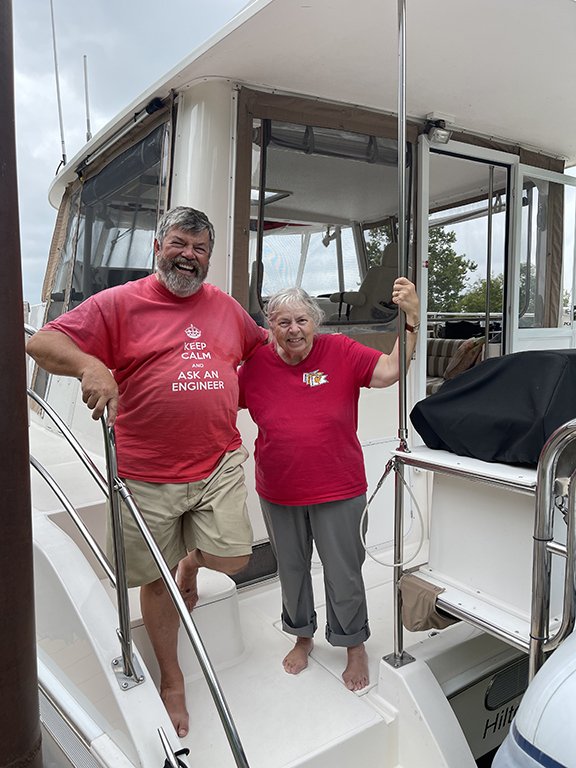
After a quiet afternoon, we joined Lucy and John in the restaurant for dinner. It was great to see them again. We were lucky that the timing worked, because they had just returned from Paris the day before! We enjoyed the evening very much, and hope to see them again.

The dock at Captain’s Quarters Restaurant is strictly for dining, no overnight stays are allowed. It is a very popular restaurant, and on a weekend, it would be heaving. Waiters will even deliver food to your boat if you prefer to stay on board! After making our reservation, Dick asked if an exception could be made to the overnight rule, and he was told that it should be okay, as they were not busy, but to speak to a manager after arrival. The manager asked Dick to call and ask if the neighbouring private marina had space, but said that although he is not supposed to allow it, he would make an exception if there was no space in the marina. Dick sent an email, and left a phone message, and later in the evening he got a call to say there was no room for us. We decided not to talk to the manager again, just stay put, as he had already given tacit approval. Nobody bothered us, and we were out by 8am with a long day ahead of us and one lock before our planned anchorage.
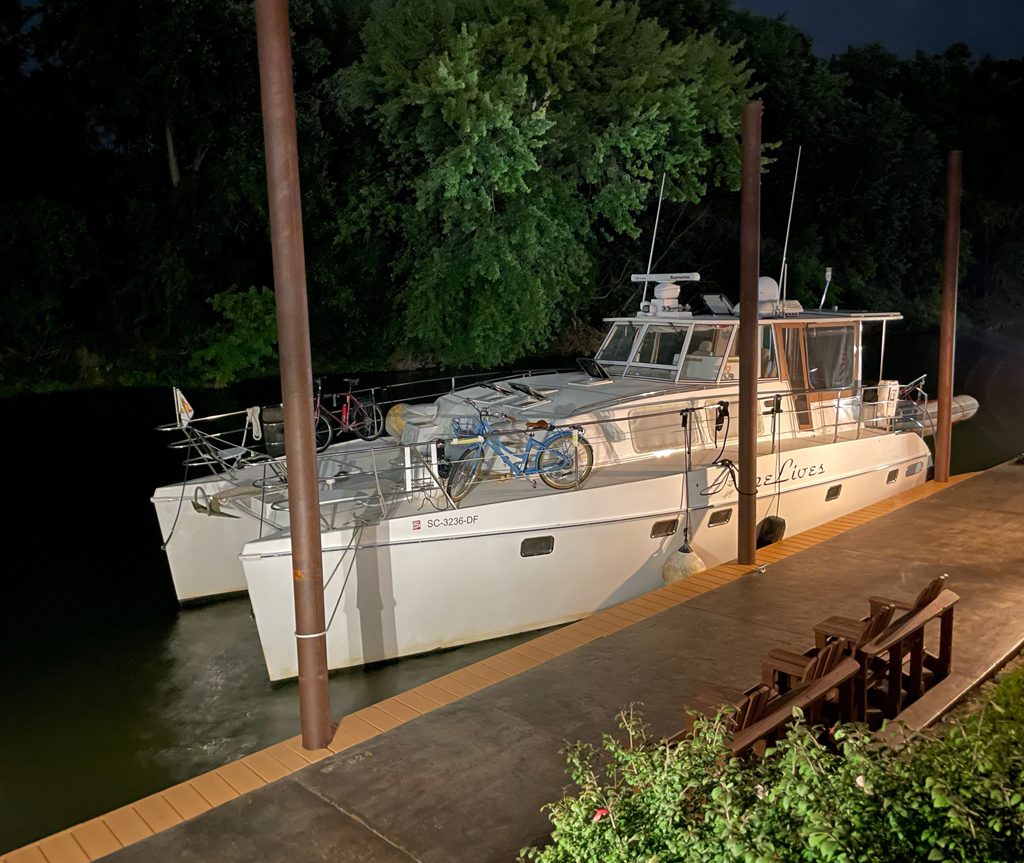
There was a bit of a flurry after we entered the lock. We were rigged for a port tie to the floating bollard, and the lockmaster called on the radio and asked us to move over to the starboard side so he could see us from his control cabin. Dick had scramble and move 3 ball fenders and a barrel, plus prepare the midships line, while I eased into the lock very slowly.
We passed under the Matthew E. Welsh bridge in Brandenburg. We found it notable because it is the only bridge we can remember seeing that is considerably higher on one bank than the other.
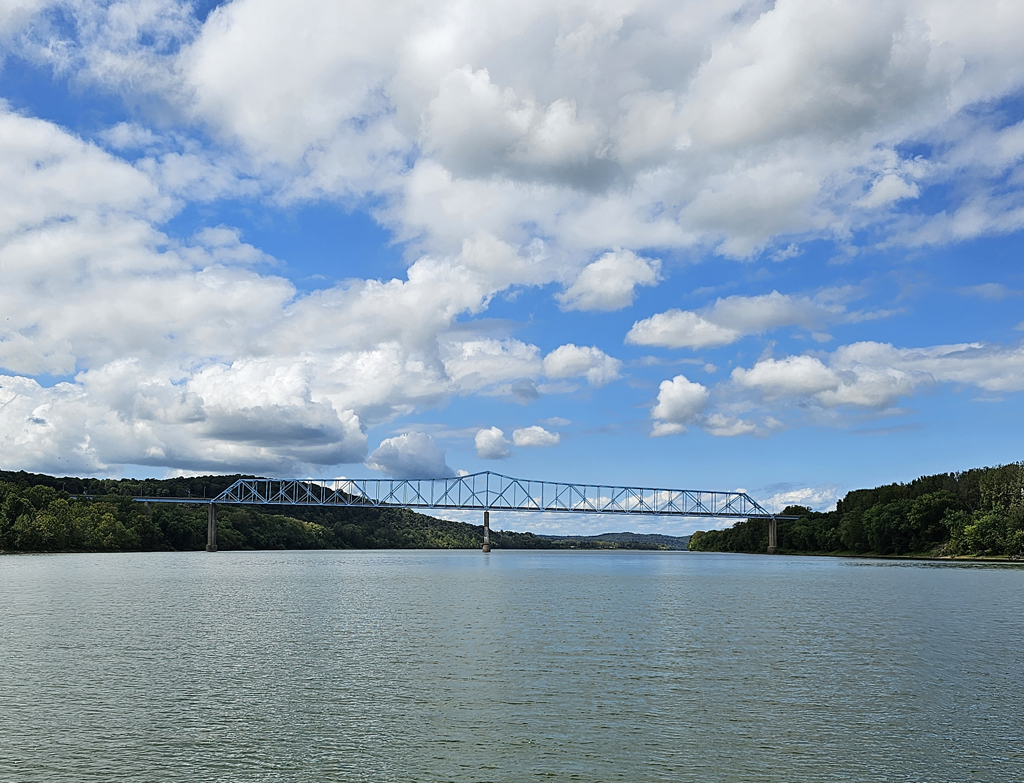
We anchored on the Ohio River, in a wide area just below Old Blue River Island, with the anchor down and set by 3:30. We anchored in about 16 feet of water. As always, I set 2 anchor alarms, but I had to increase the alarm radius because Dick had put out about 130 feet of chain. We expected the current to keep us in line, parallel to the shore, but the wind blew us around. We went right to the edge of the allowed alarm circle and stayed there all night. Even after the wind died, we stayed nearly perpendicular to the shore. The effect on the boat of wind and current is often mysterious and unexpected. A good reason to set our anchor in a location with enough space to swing in a full circle.We tested the spotlight after it got dark. It had been replaced, along with its controller, in the spring, but we do not travel after dark, so we have never used it. It was likely that we were going to need it during the J.T.Meyer lock delay, hence the testing.

The next morning, we had another early start, with over 70 miles to go and one lock. It was 61 degrees and misty, although there was plenty of visibility. As we headed down the river, I had shoes on, a windproof long-sleeved shirt over my usual t-shirt, and my fleece-lined vest (gilet) draped over my knees. Dick, on the other hand, had just his usual t-shirt, shorts, and bare feet, and was perfectly comfortable. I am not complaining – I will take those temperatures over 90F any day!
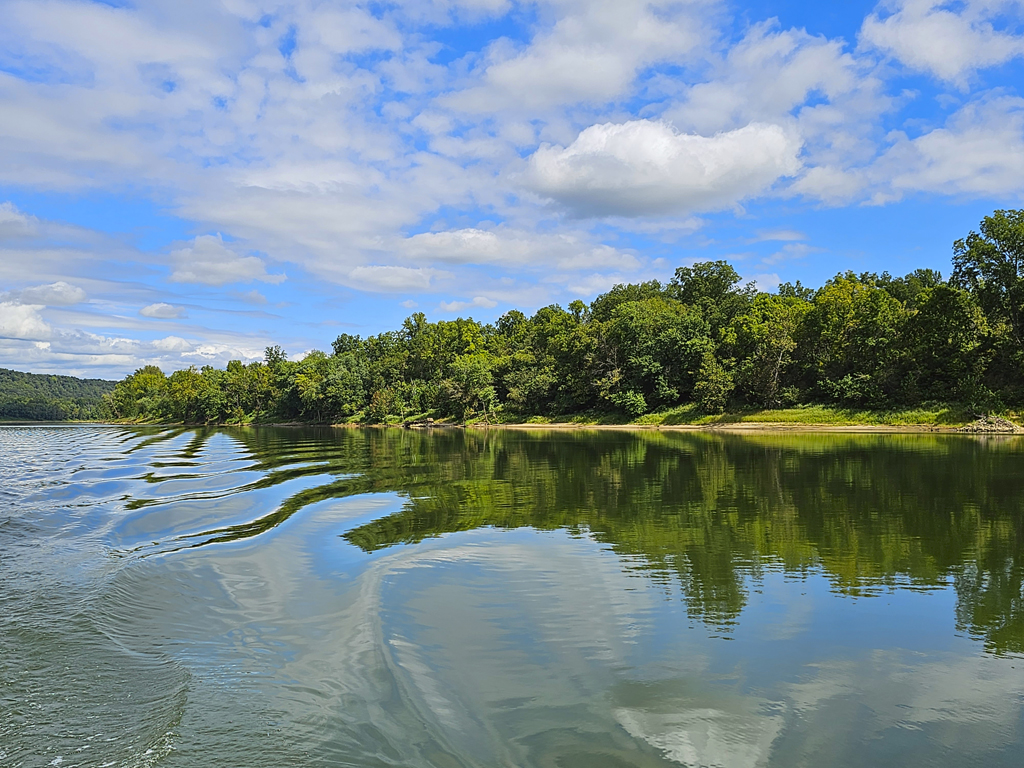
We saw a pair of bald eagles fishing. An interesting observation, any bald eagles I have seen perched on trees on the Ohio River have been well down in the branches, among the leaves and hard to spot. On the Mississippi, they seemed to prefer the top of a dead tree, well above the canopy. Perhaps this is learned behaviour from parents?
I have spent the last week looking for flamingoes. Yes, flamingoes. Apparently, they were blown far north by hurricane Idalia, and have been seen outside Pittsburgh! Naturalists are sure that once they recover from the journey, and are feeling less stressed, they will have no problem making their way south before winter. So far all I have seen are a few great egrets, and the expected great blue herons.
This was the same two-day stretch of pretty but all the same scenery, that we found so boring when we travelled upstream. Add to that, little and patchy mobile signal, so I couldn’t even keep up with the Marine Traffic app that lets me see what commercial shipping (tows) are coming up.
The time zone changed from Eastern to Central, so the long day became an hour shorter. Yes, I know that’s an illusion, but as far as I am concerned, we expected to stop at 4:30 and instead it was 3:30!
We passed Mason’s Lighthouse Landing Castle, a stone folly built by hand over a period of 15 years. It is now a wedding venue. It’s called Mason’s Landing, but there is no place for any boat to dock or even beach.

At Cannelton Lock we were treated to a demonstration of how not to lock through a USACE commercial lock. Start by waking the pleasure boat as you rush to get past and into the lock first. No life jackets (USACE rules state that they are mandatory for everyone on board). No lines, holding on by hand only. Let go before the locking is finished. Exit before the horn goes, before the doors are even open. Start fishing in the lock channel, forcing the much larger pleasure boat to detour around.

We were anchored by 3:15 behind Anderson Island, a little closer to the shore than I was happy about. All was well though. Overnight there was little motion from tows, and the slight breeze did not move us much against the current. We were up anchor and underway by 8am.
We passed American Heritage, a passenger cruise ship at Henderson.
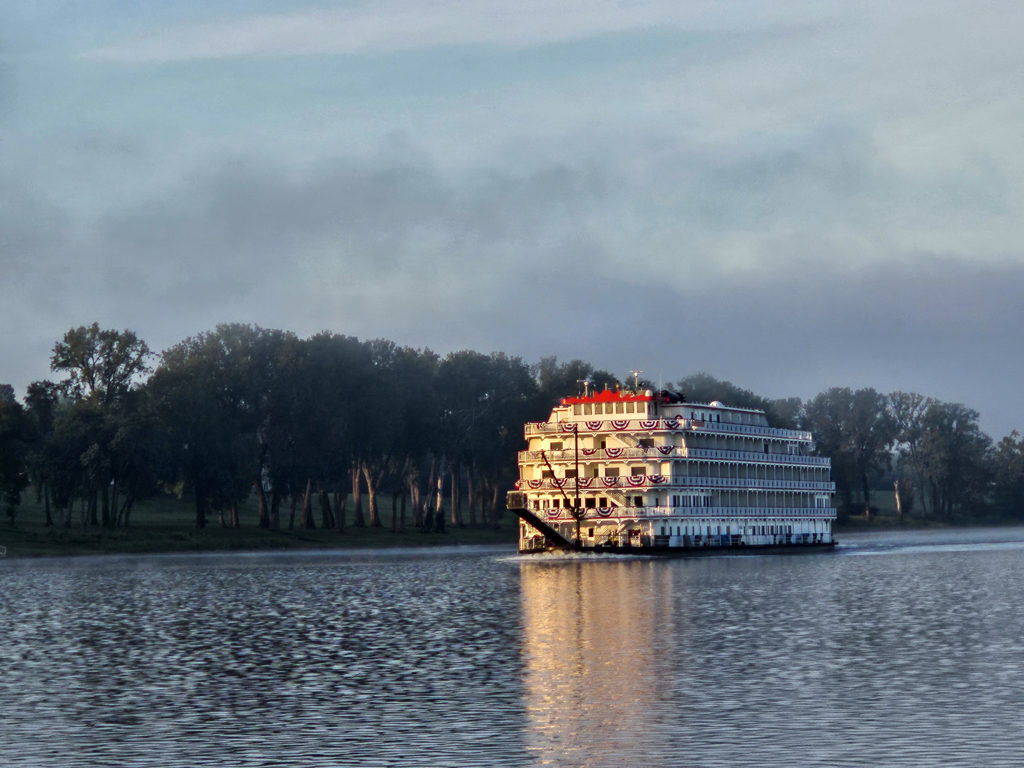
As we headed downriver, we discussed various options for the J.T.Meyers lock. Readers may remember that I mentioned in the last issue that they are operating only the small chamber while repairs are made to the large chamber. This means that any large tows have to split, requiring a 3-hour transit instead of the usual 1-hour. Dick spoke to the lockmaster and was advised that a downbound pleasure craft will only be passed through when they transition from upbound to downbound, and the helper tow repositions. When a tow splits, the first half of the barge train is pushed in and uncoupled from the rest of the train, and then when those barges have been lifted or dropped, the helper tow pulls them out of the lock. The lock is then turned around (i.e. filled or emptied), and the remaining barges, plus their tow, go through and are reunited with the rest of the waiting barges. Hence the need to reposition the helper tow. It is faster overall to run a series of waiting tows in one direction, and then change, than to follow the normal procedure of one up and then one down. The only other option for us, would have been if there was a short tow (although not a chemical barge), who would agree to share the lock with us.
The lockmaster Dick spoke to said that no appointment could be made. Instead, we should get to the lock as early as possible, and we would then be added to the queue to go through, either with a short tow, or, more likely, with the helper tow the next time they change from upbound to downbound. We can look online at what is called the “Queue Report”, to get a sense of how many tows are waiting, and their size. (As it happens, Dick does this anyway, even when there are not extraordinary circumstances).
We were scheduled to stay in Evansville overnight, but it is 5 hours’ travelling time from there to the J.T.Meyers lock. One option is to leave at first light (6am), and run fast to get there as soon as possible. Another option would be to stop briefly in Evansville, just to take on fresh water, and then run south using the remaining daylight and anchor close to the lock. Another critical consideration would be having good cell phone service. A Looper, who came up a few days previously, reported that they waited 9 hours, and went through in the dark, but they had no phone service where they waited below the lock. They could see later that they had missed 2 phone calls. It is possible that they were being called forward and did not know.

We passed Scuffletown Island, all that is left on the map of the former city of Scuffletown. It was a notorious stop for the captains and crews of the flatboats that plied the river during the 19th century. After a few hours of getting liquored up, fights would break out between the crews, so the city got its name. It was mostly destroyed in the floods of 1913, and the subsequent flood of 1937 finished the job.
We were asked to float free in the main chamber of Newburgh Lock because so many of the floating pins are broken. Not our preference, having done it a couple of times on the Mississippi, we prefer to be secured. I rushed to put out our remaining fenders on the port side (we were already rigged for starboard), just in case we bumped the lock sides, but it was a very gentle drop of only 18 feet and all was well.
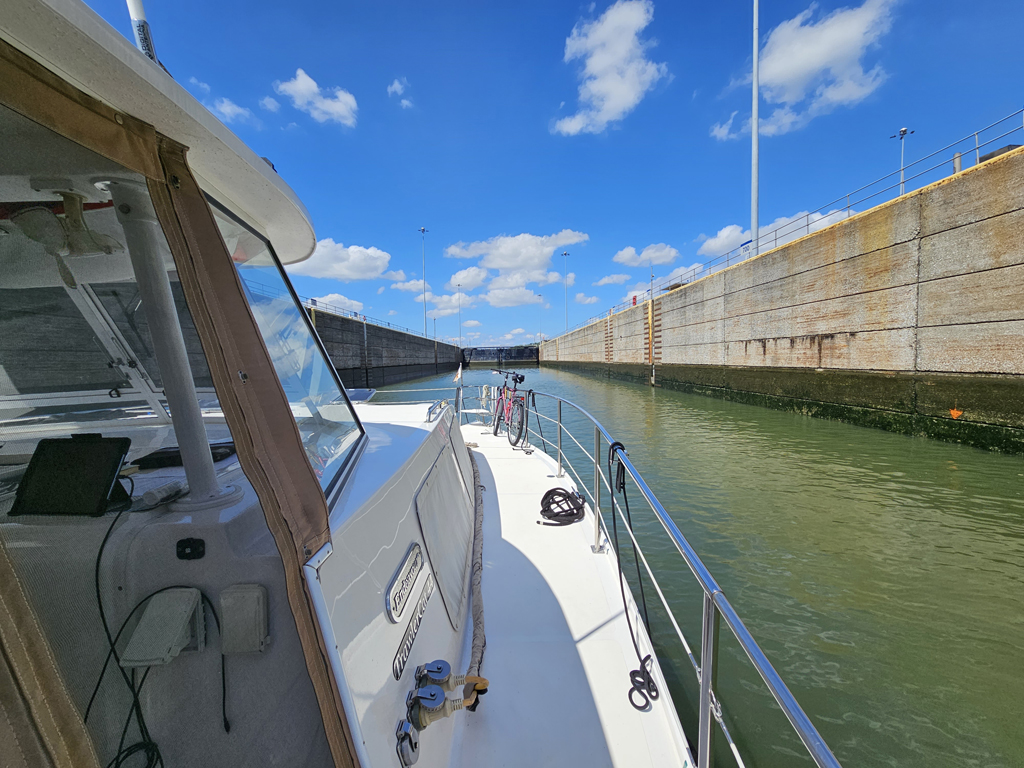
As we approached Evansville, I took the helm, and Dick got onto his computer to check the lock queues for J.T.Meyers lock. It appeared that after the then current upbound tow, there were no others waiting, and many in line to go down. There would be no point in rushing to get there, only to have to wait for many hours. We decided that we might as well stay overnight in the marina as planned. We were at the dock by 2:45.
We got up at 5am, and were underway by 6:10, after checking the queue report and consuming our essential morning coffees. Dick had spoken to the lockmaster the evening before, and would call again after he came on shift at 7am.
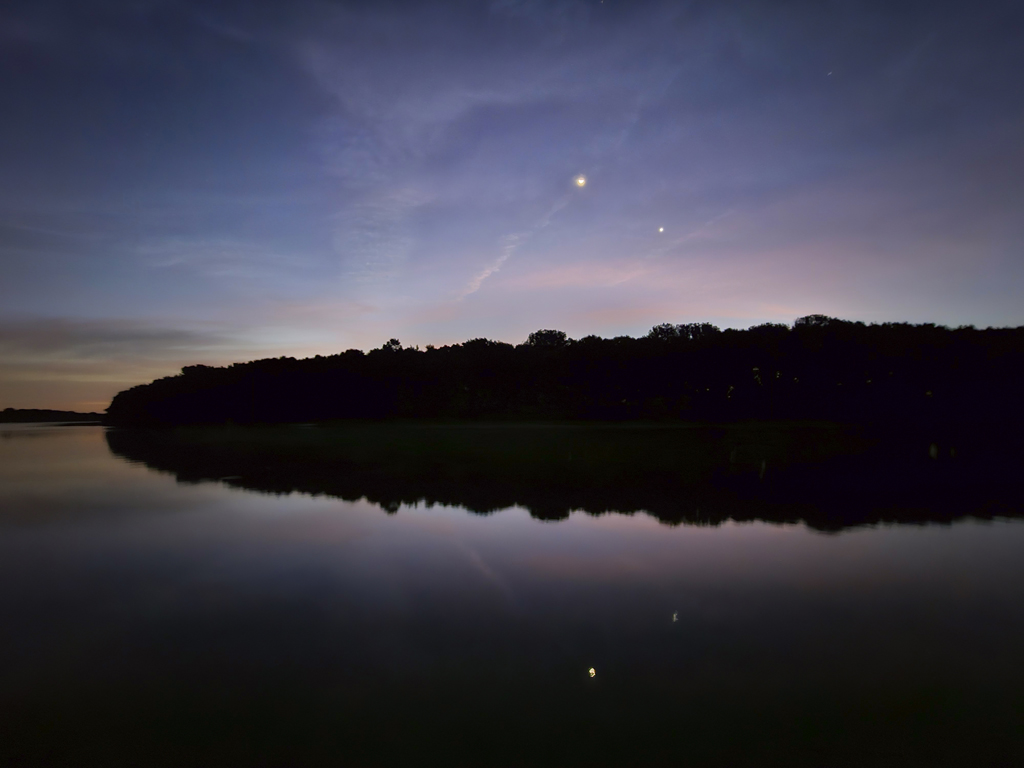
Dick took a walk around the boat to be sure the running lights are working. This, in addition to our earlier testing of the spotlight, were precautions we hope never to have to use. All boats over a certain length must have and turn on running lights in times of poor visibility. There are slightly differing requirements, depending on size. At the bow, we have a red light on the port side, and a green light on the starboard side. These must be visible from a mile away on a dark, clear night. Above, at the stern, is a white light. This is also our anchor light, visible 360 degrees. The white light must be visible for 2 miles on a dark, clear night.
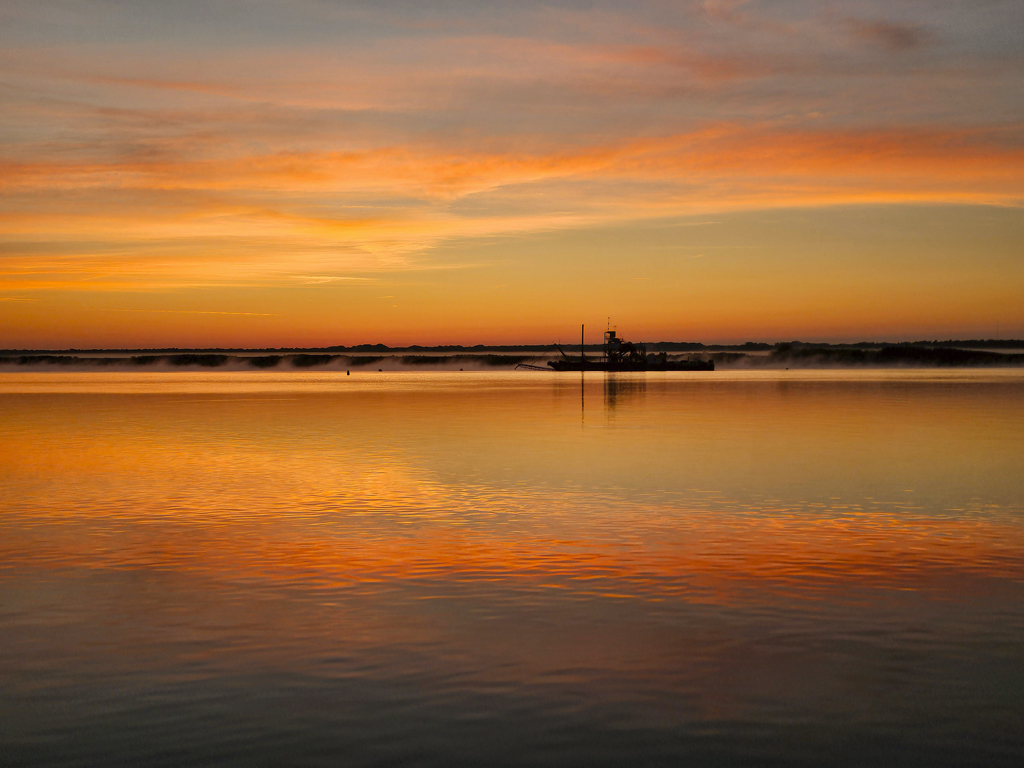
We ran fast for an hour, to arrive at the lock as early as possible. Conversation with the lockmaster from 5 miles away suggested that it could be a six-hour wait, but we should get close, and he would try to sneak us though. He took Dick’s phone number. We needed to watch for options for anchoring as near to the lock as possible, with good cell service and out of the way of the waiting tows. We arrived at the lock at 10:10, just as the helper tow was pulling the first set of barges out of the lock for the last of the upbound tows in the queue. After the tow brought up the second set of barges and re-attached, we were able to go through the lock with the helper tow. Note that not only does the lockmaster have to arrange this, the captain of the helper tow has to be willing for us to share the lock. We entered the lock at 11:35, so we only waited 85 minutes. We had expected, and been prepared for 6 to 9 hours!
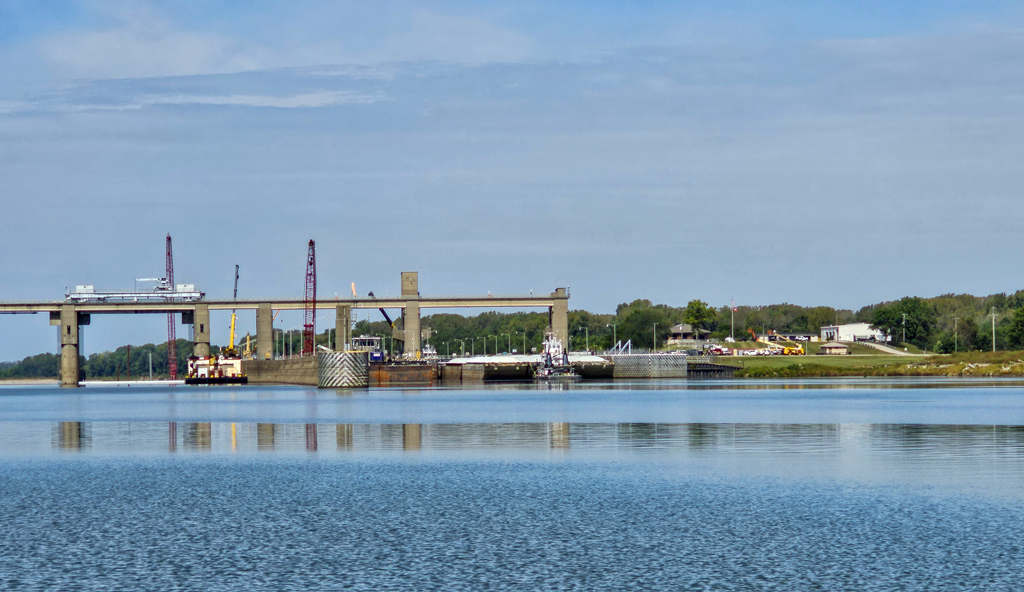

We passed Old Shawneetown, all that remains of what was once an important city. It was a major government administration centre for the Northwest Territory. In 1816, the first bank to be chartered in Illinois started in a log cabin. This bank refused to buy the first bonds issued by the city of Chicago, considering them a poor investment, on the grounds that no city located that far from a navigable river could survive. Chicago’s population was 2.7 million, while Old Shawneetown’s population was 75 in the 2020 census. If you visit Old Shawneetown, you can still see the brick building, one of the first two in the city, that was built to house the bank in 1822.
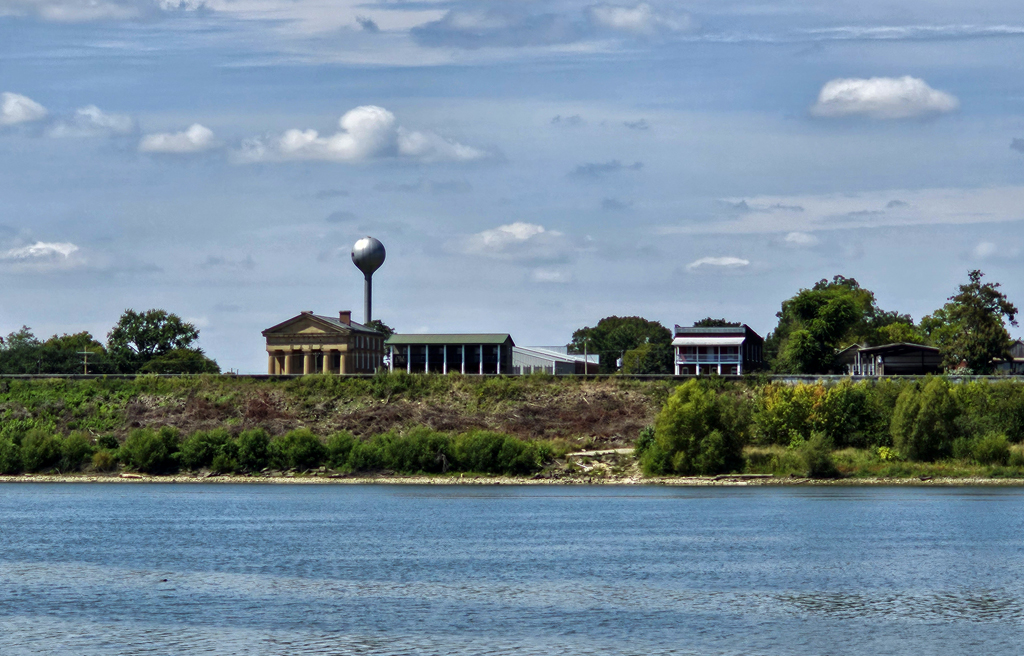
On an island in the middle of nowhere we passed a johnny-on-the-spot, a very long way from any town. Dick wondered how often it is emptied, and by whom? You know you are on a boring stretch of river when the only thing of interest to photograph is a biffy.

We anchored just across the river from Cave in Rock State Park, and below the island, giving us protection from floating debris. We were set by 3:15. After 9 hours underway, it had been a long day. Dick grilled burgers for dinner, then we sat and watched the sunset, except it was cloudy, so there wasn’t one. There weren’t any flamingoes either, just an egret and a few turkey vultures.
Rain started at about 6am, but we were already buttoned up, as it had been forecast. It was the first rain we have seen for nearly 3 weeks. We were anchor up and away before 8am.

We were somewhat surprised to discover that the Smithland lock had both chambers working, so we went straight in. We had expected as much as 4 hours delay. Again, we were asked to float instead of tying off. We arrived in Paducah and were tied up by 1:30, better than the most optimistic forecast Dick had for the day.

I know that some of my readers may wonder why we so dislike having to move the boat once we are tied up, as happens on occasion. When we arrive at a dock or marina, I am ready with a line at midship, that I throw over the cleat on the dock, and then secure back on board. I then move to the stern, and the midships line will hold us in place while Dick reverses against it to bring in the stern, where I am ready to throw a second line over a cleat and secure it. Dick can then stop the engines, and the real tying up begins.
Dick gets onto the dock, while I stay aboard, and we first make sure that we are where we want to be with respect to cleats and power pedestals (and possibly other boats). Adjustments are made if required, by pulling on one line, while letting out the other to move us into position. Next, Dick will loosen the midships line, and add a second one to the same deck cleat. One of the lines then goes to a cleat on the dock that is forward, and the other goes aft. Tightened, these lines ensure that the boat does not move forwards or backwards, but still floats independent of the dock.
After putting down fenders as needed, we then take a line from the stern pontoon opposite the dock, across, under the dinghy, and secure that to the dock. The initial short stern line is then removed and stowed for when we leave. A bow line is taken loosely to the dock, just to make sure Nine Lives cannot move farther away from the dock at the front.
The way these lines are set allows the boat to move independently of a floating or fixed dock, without the lines continually snapping tight, which is hard on the cleats, and will eventually fray the lines. We’re not done yet.
Power needs to be connected. The plug is nothing like what one has at home or in a garage. It is a thick, heavy line (or two lines, which in our case are held together in a long brown canvas tube). The ends have 3 prongs, one with a hook on it, that ensures that it can only go one way into the outlet on the power pedestal. Once in, it twists, to lock into place. Often Dick must first brush away spider webs, and he always has to kneel on the dock to fit the cord into the receptacle under the pedestal’s cover. Occasionally, the only way to accomplish this is from a prone position. I am very glad that lying down on a dock with spiders (and splinters if it is a wooden dock), is not part of my share of the boating responsibilities!
Last, and new to our routines this year, location permitting, Dick will attach the water hose to the inlet at the back of the boat. First, he allows the water to run for a while by hosing down Nine Lives’ deck, to ensure that no stale water is going into our tanks.
When we leave, or if we have to move, the whole process, that takes us 20-30 minutes, is done in reverse, although it is much quicker to untie. In addition to not snapping the lines when wakes, or even just the wind, moves the boat around, this way of tying also allows for a change in water depth due to tides. Even on the rivers, the depth may change after heavy rain upstream.
So, if you are still reading after that long explanation, you can understand why we hate being asked to reposition once we are all set!

After a quiet afternoon, we made our way to Cynthia’s, one of our favourite restaurants on the Loop. Dick started with their excellent smoked salmon, and I tried a new offering, tempura shrimp with fried green tomatoes with chopped peppers, tomatoes, and tomatillos. Dick’s main course was bacon wrapped pork tenderloin with a bourbon and honey sauce, and I had the veal scallopini with a wild mushroom and port wine reduction. Desserts completed the meal with the signature flourless chocolate slice for me, and crème brulee for Dick. It was a lovely evening in a beautiful historic setting. For the first time in 4 visits, we are in Paducah with the temperatures in the 70’s, instead of the 90’s, making the walk to and from town a pleasure as well.


The next day was all about catching up and laundry. Dick worked on the next few weeks of the voyage, booking marinas and checking fuel prices, while I worked on the blog and the pictures. We were thrown about more than usual by wakes. Paducah has always been subject to a lot of wakes, but this year, on the rivers, there is even more low water than there was last year. There have been complete closures of the Ohio River just above the confluence with the Mississippi, followed by a one-way system for tows. Add to this the partial closure of the J.T.Meyers lock north of Paducah, and there are many more barges and tows sitting on the river around Paducah. For the first time, we have seen crew changes for the tows. A workboat races around, picking up crew and dropping them off, before heading to the next meeting point for more. This workboat has powerful outboard engines, and follows the usual Ohio River custom of completely ignoring docked vessels, throwing huge wakes from very close to us.
I won’t be writing much about the city of Paducah this time, as it is our 4th visit, and I have written in past years.

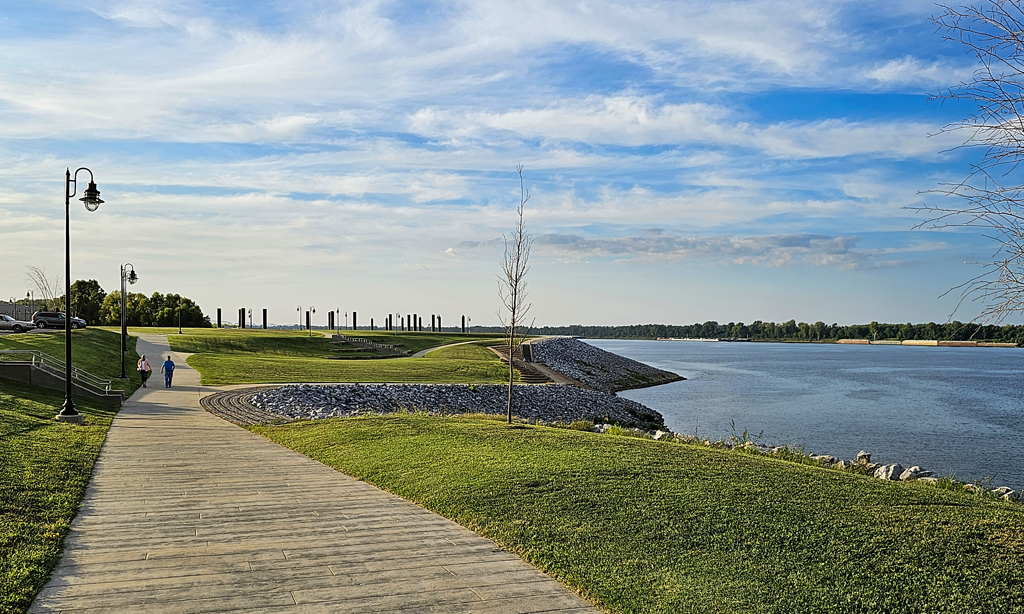

In the evening, we decided to give Grill 211 another try. We had a less than stellar experience on our first visit to Paducah, but reviews were very positive recently, so we made a reservation. As we walked through the park, I pointed out to Dick that I was wearing a new outfit. I had chosen a new, black and white sleeveless top, with black trousers, and a white sun shirt. Dick paused to look (many years of marriage ensures that as long as there is a vague shape next to him, who speaks with a familiar voice, nothing else is noticed). His immediate comment was, “oh yeah, you look like a referee!” Later he tried to row back a little by complimenting my choice of matching onyx and jet jewellery, but it was far too late for flattery!
Our thoughts about Grill 211 are mixed. The setting is what we always enjoy, a historic building, repurposed. The mixed tile floor and the brick walls were particularly interesting, and I love to imagine all the things those walls and floors have witnessed over the years. The menu seemed a bit odd for a steak house, with several Thai curries, and other items that were definitely Asian, as opposed to fusion cuisine. We had not been able to look at the menu earlier, because the restaurant has only a facebook presence, with no information or menus. The steaks were tasty, but not the expected restaurant quality. What made it worse was the truly dreadful, cheap plastic steak knives, that were unable to effectively cut the vegetables, let alone the meat. A poor steak knife always makes the meat seem tough. The restaurant was nearly empty, where Cynthias had been hopping the night before.



We will be giving Freight House another try this evening. It was a disappointing experience last year, but they seem to have upped their game somewhat and it is now the top-rated fine dining restaurant in Paducah. We have booked the tasting menu (48 hours notice required), and we are interested to see how it compares to the tasting menus we enjoy in UK.




